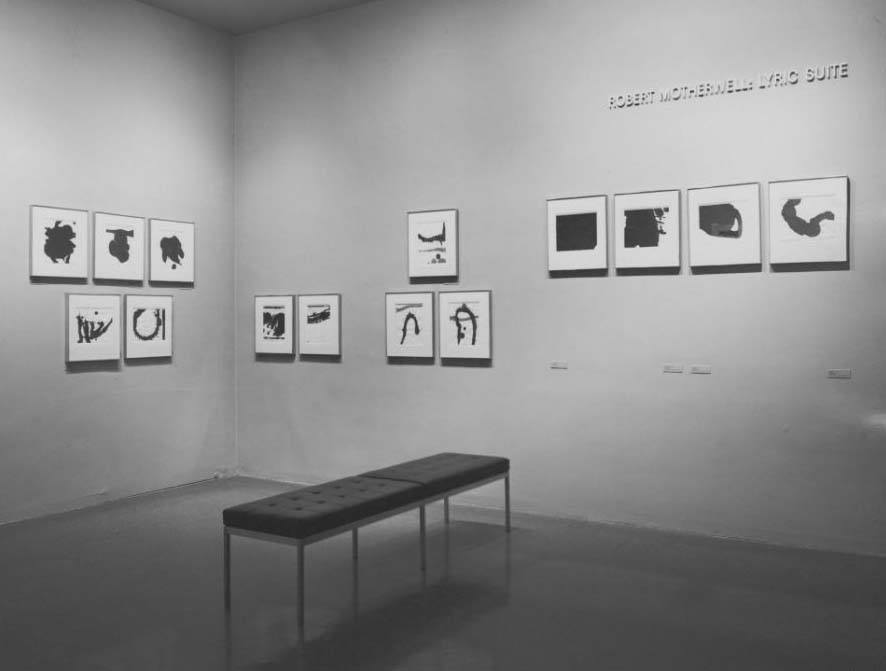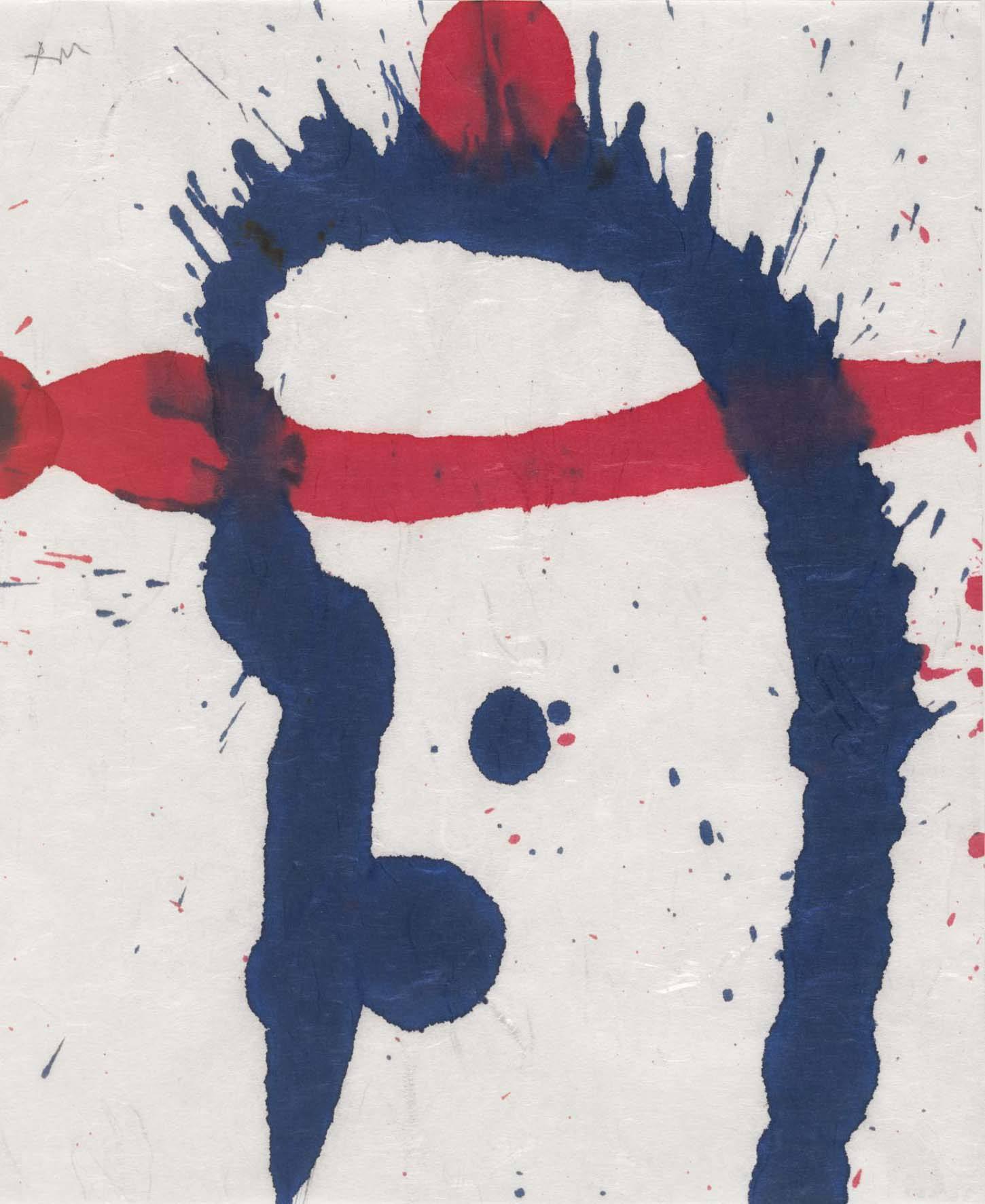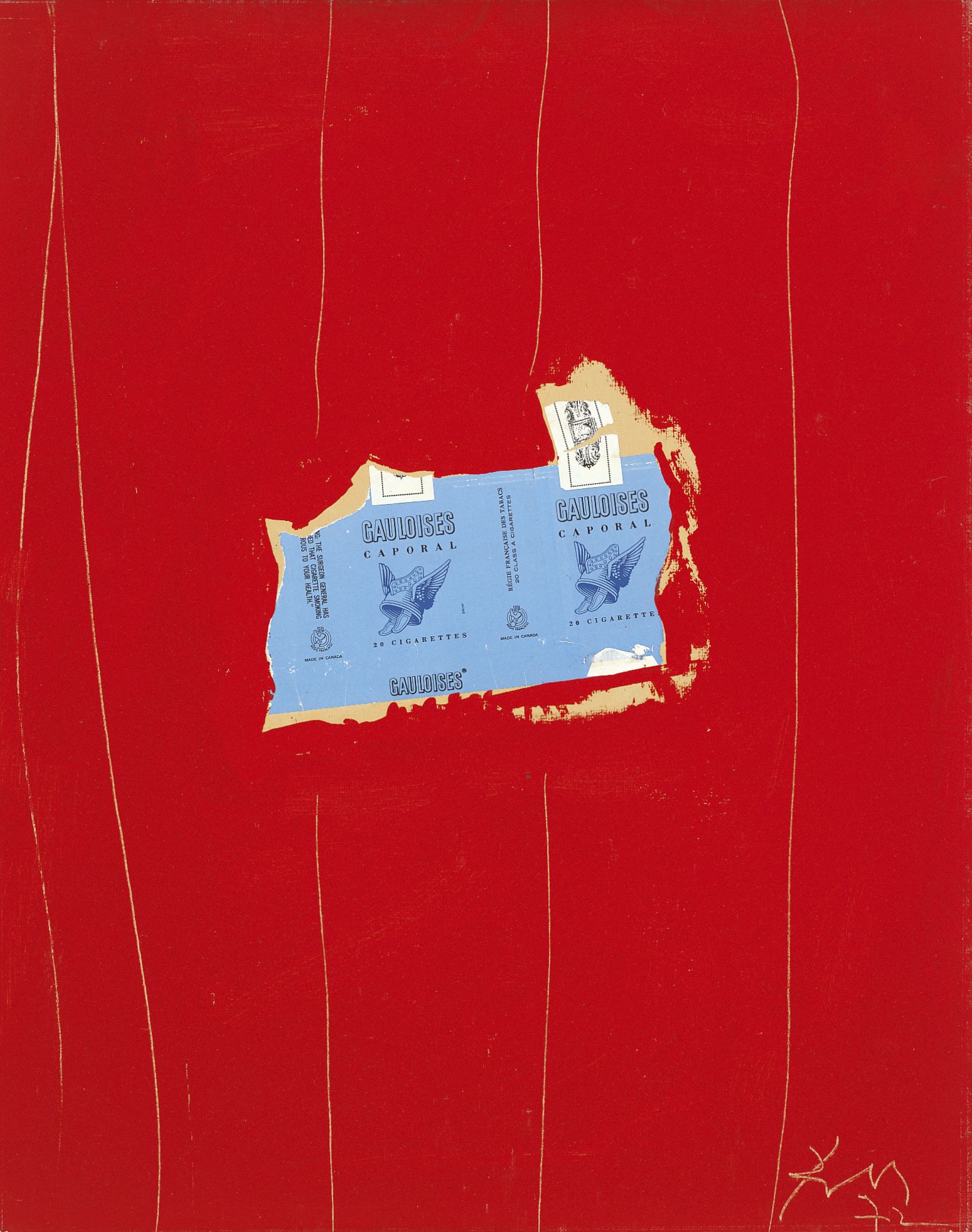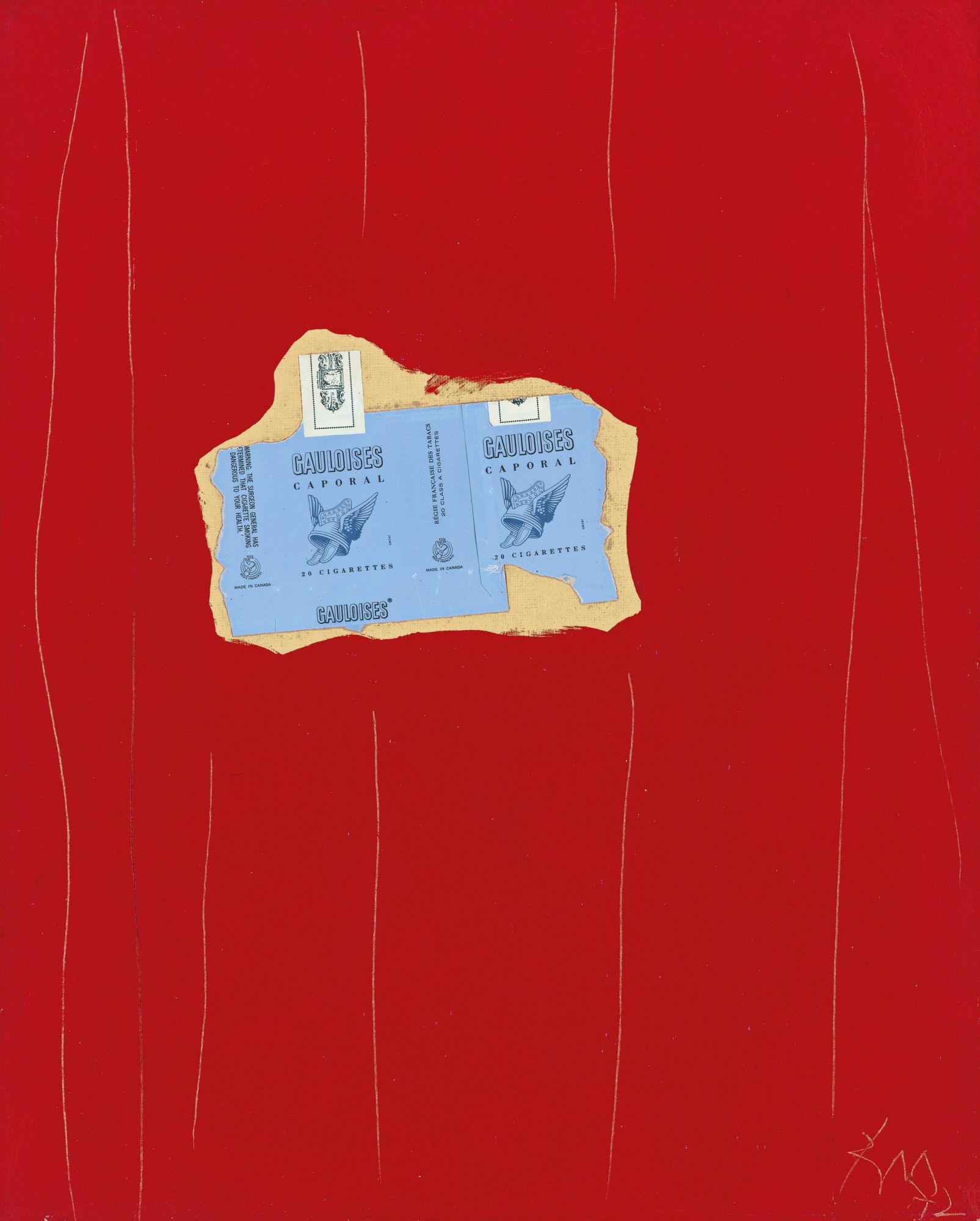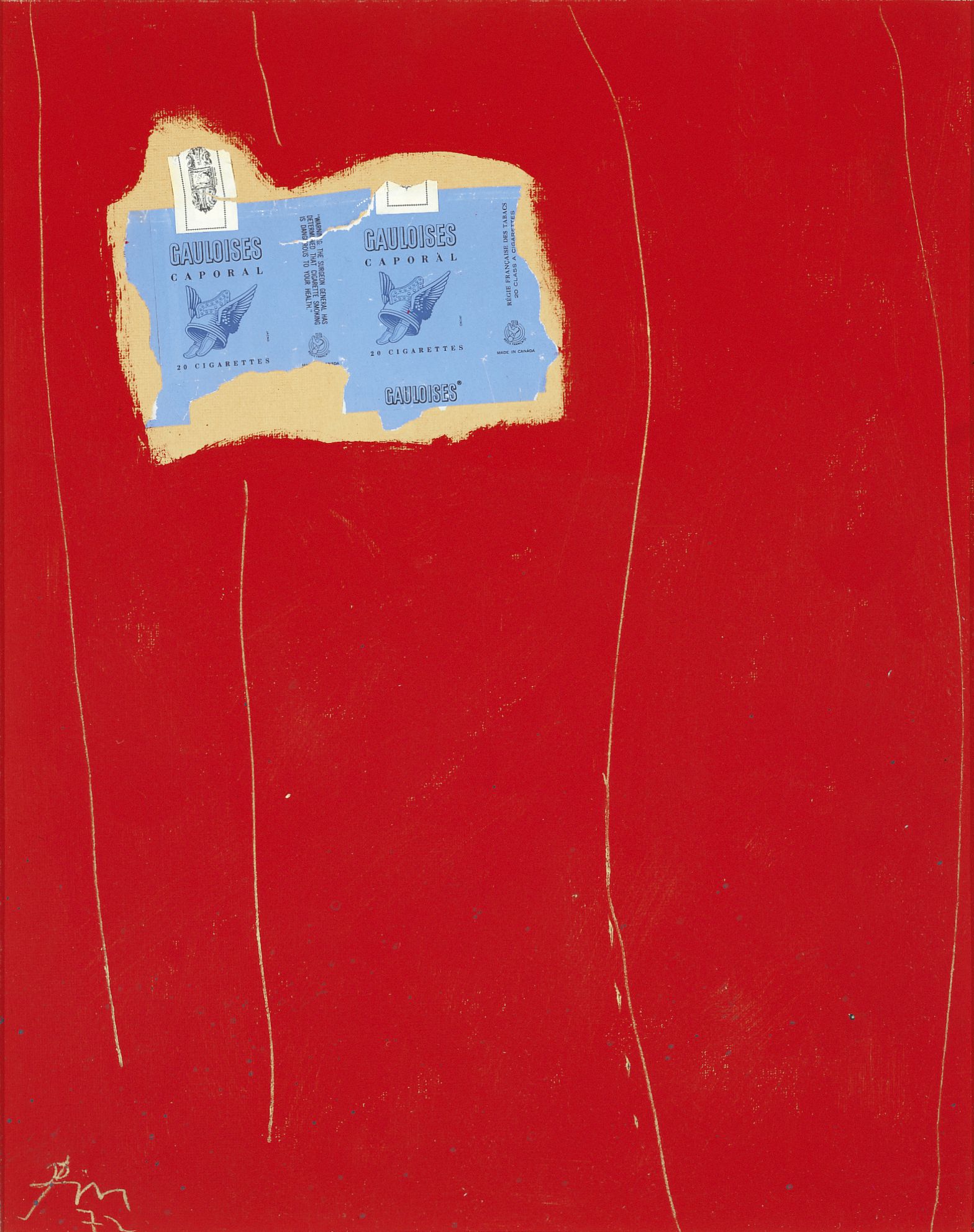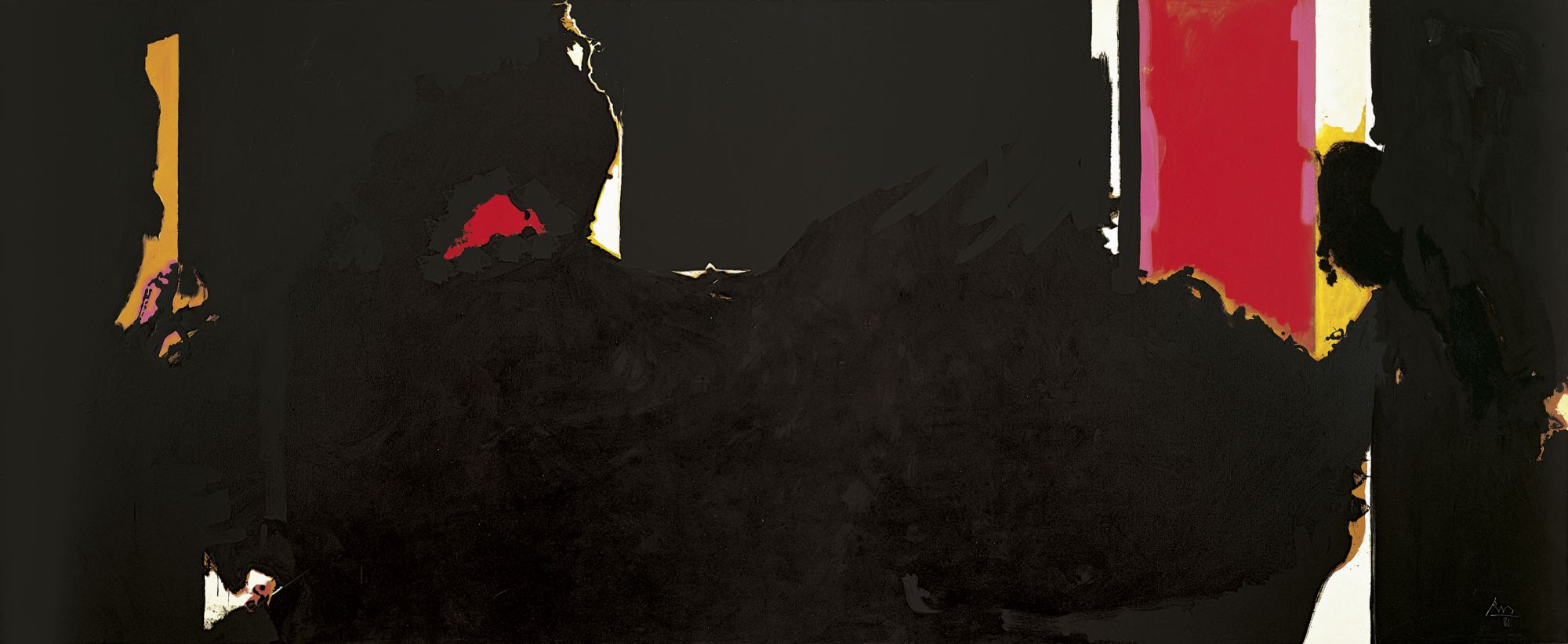Your browser is out-of-date!
Update your browser to view this website correctly. Update my browser now
1967 - 1979
The Open series, Move to Greenwich
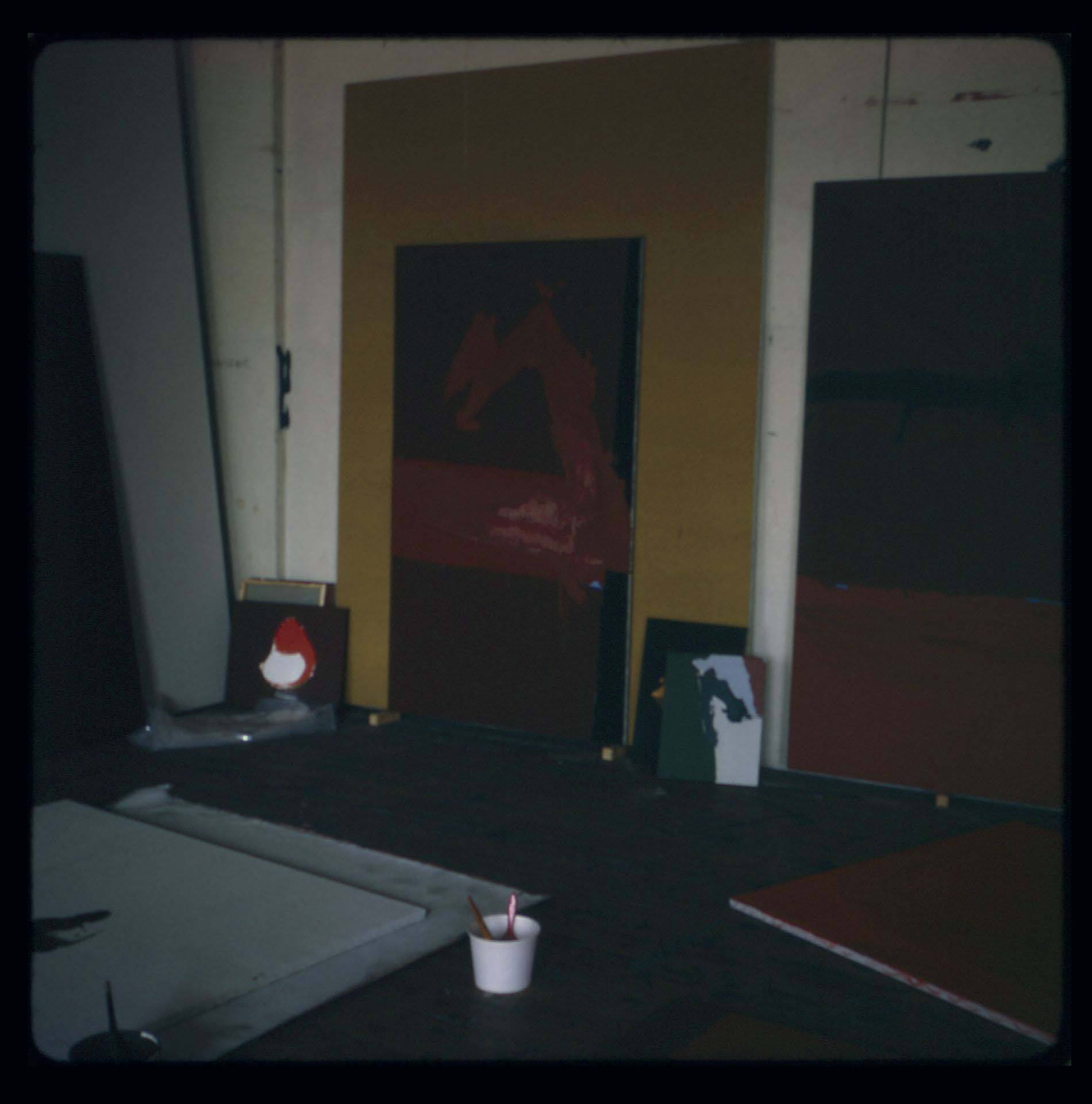

1967
In March, Motherwell notices a recent painting, Summertime in Italy, leaning against a larger canvas primed with an ochre ground. Finding the proportion of the smaller canvas to the larger one pleasing, he traces the outline of it in charcoal on the ochre ground. He decides against modifying the canvas further and provisionally titles the work Ochre Door; this work will become Open No. 1: In Yellow Ochre.

Lyric Suite, 1965
1967
Motherwell donates twelve Lyric Suite drawings to the Museum of Modern Art in memory of Frank O’Hara.
1967
With Arthur A. Cohen as co-editor, Motherwell revives the Documents of Modern Art series, which he edited in the 1940s, only now under the title Documents of 20th-Century Art, published by Viking Press. As with the earlier series, the Documents books are intended to make the writings of artists available to a wider public.
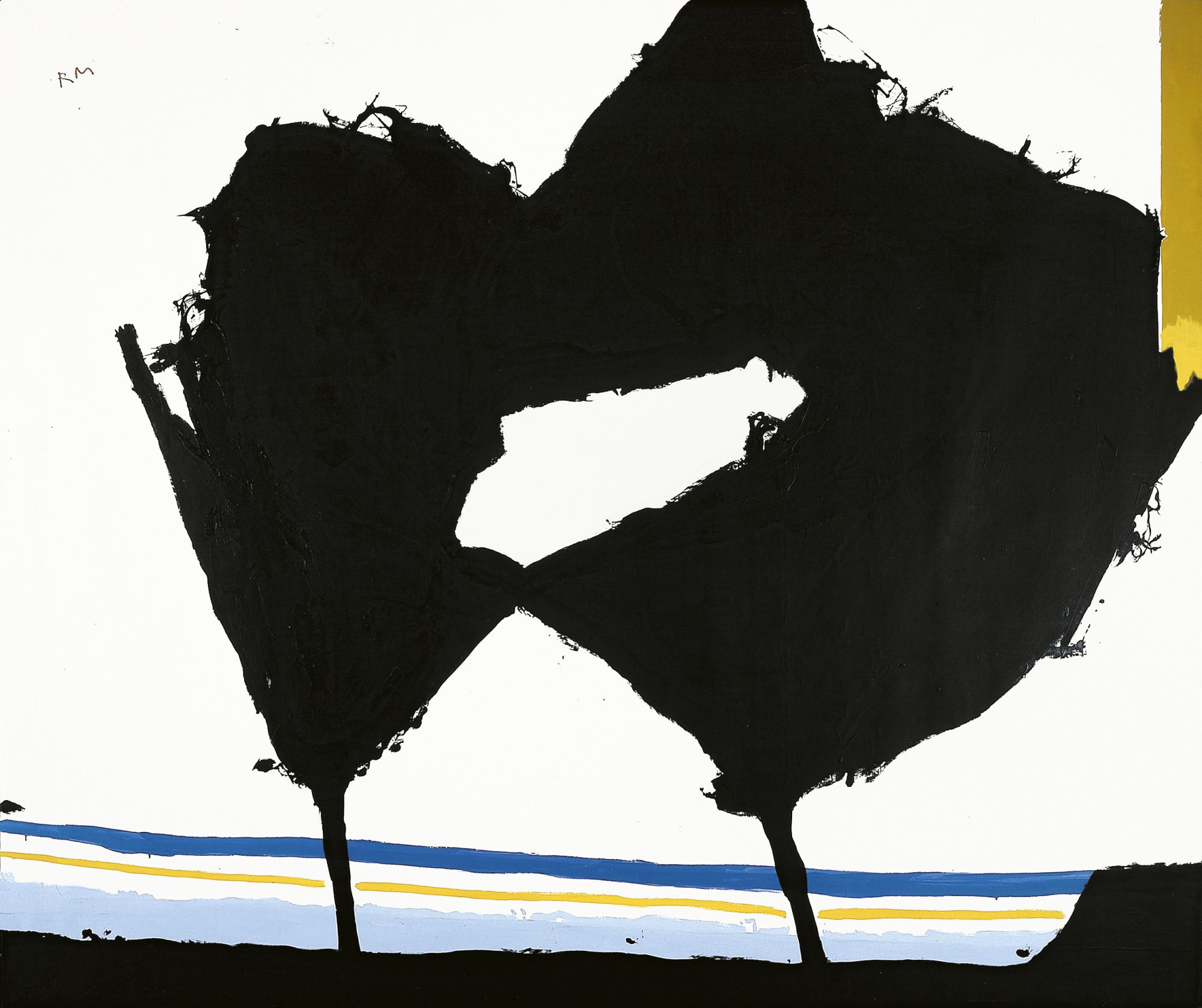
New England Elegy Mural (Second Variation), 1966
1967
Motherwell’s New England Elegy Mural (Second Variation) is exhibited at Expo ’67 in Montreal.
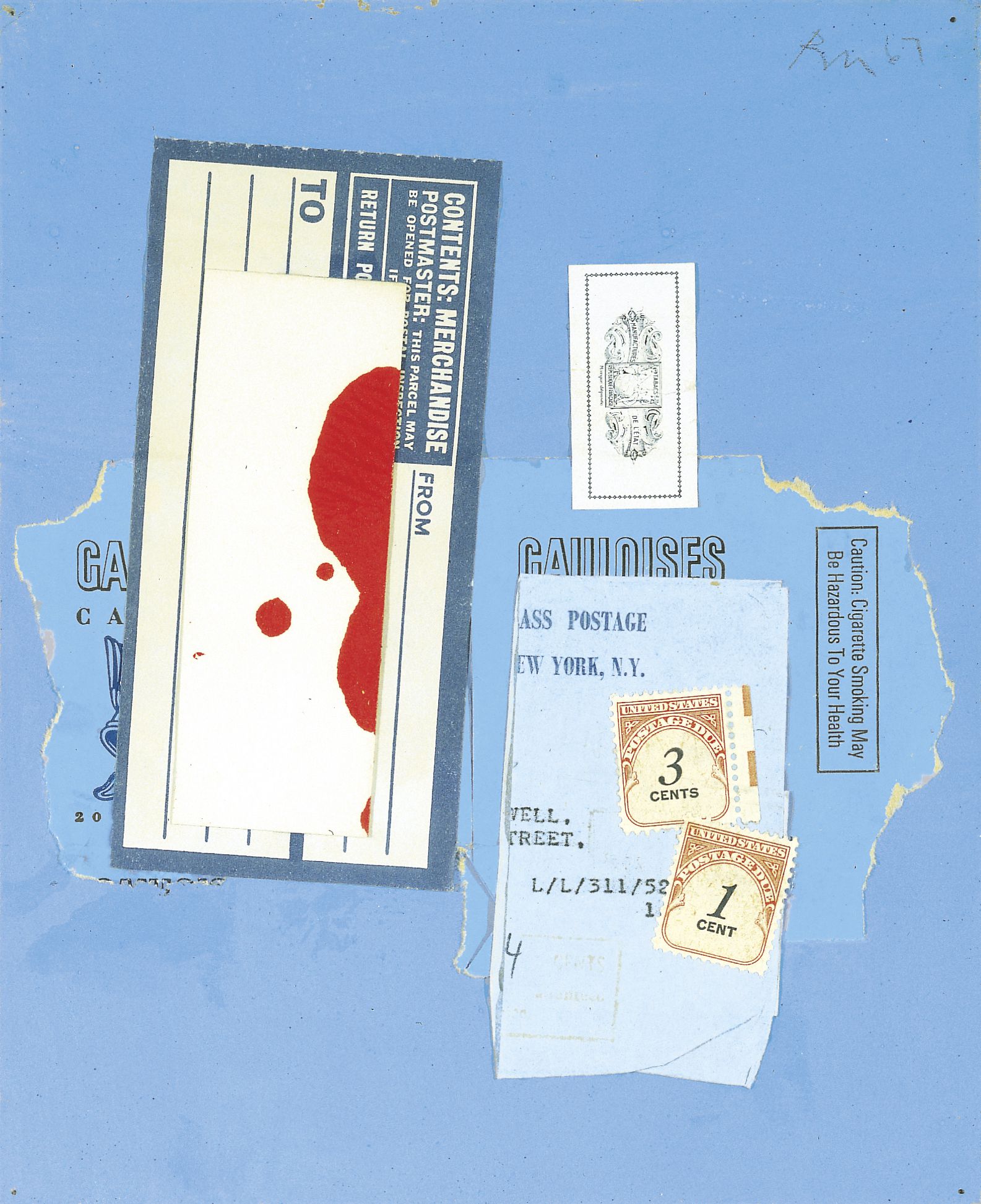
Untitled, 1967
1967
Motherwell and Frankenthaler spend a long summer in Provincetown as their house on East Ninety-fourth Street is under renovation. He creates a number of collages that include packages of Gauloises cigarette wrappers, which he acquires from the writer B.H. Friedman, who recently purchased the house next door to Motherwell’s.
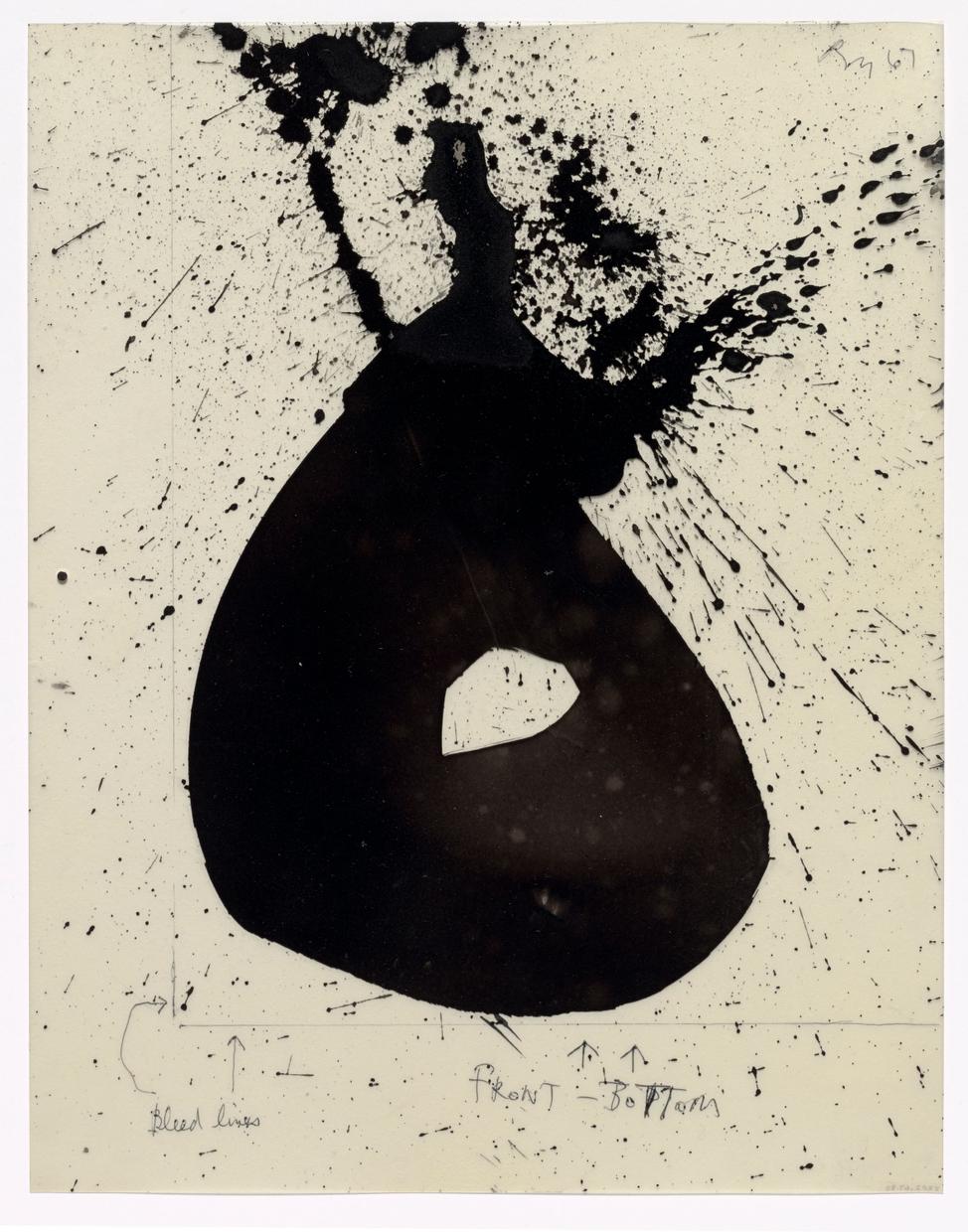
Untitled, 1967
1967
In September, Motherwell signs a contract to illustrate Arthur Rimbaud’s Season in Hell with Bill Berkson, who is editing a new publications program at the Museum of Modern Art.
Motherwell makes a series of ink drawings on vellum for the Rimbaud book and contributes one of them to In Memory of My Feelings by O’Hara. (The Rimbaud book project is later abandoned.)
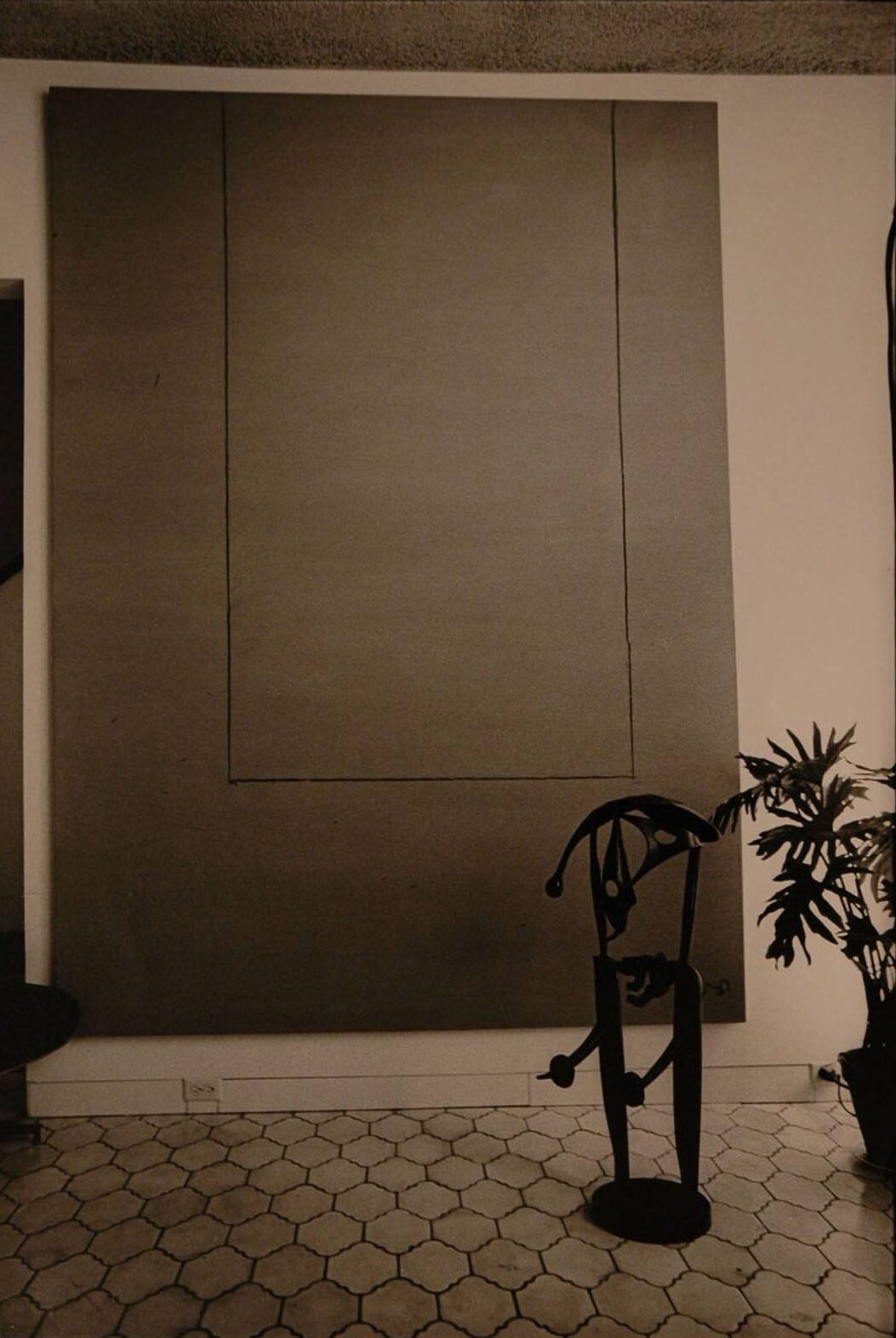
Open No. 1: In Yellow Ochre installed in Motherwell’s 173 East 94th Street, New York home, October 1967
1967
Returning to New York in late September, Motherwell moves into a new studio on East Seventy-Fifth Street. In late October, he has Open No. 1 (then known as Ochre Door) installed in his newly renovated brownstone at 173 East Ninety-fourth Street. Within days, he rotates the canvas so that the rectangular charcoal lines descend from the top of the canvas instead of ascending from the bottom. He re-signs the canvas to affirm this new orientation, finalizing the first painting in what he will call the Open series. In the months that follow, he continues to explore the possibilities suggested by the first Open painting.
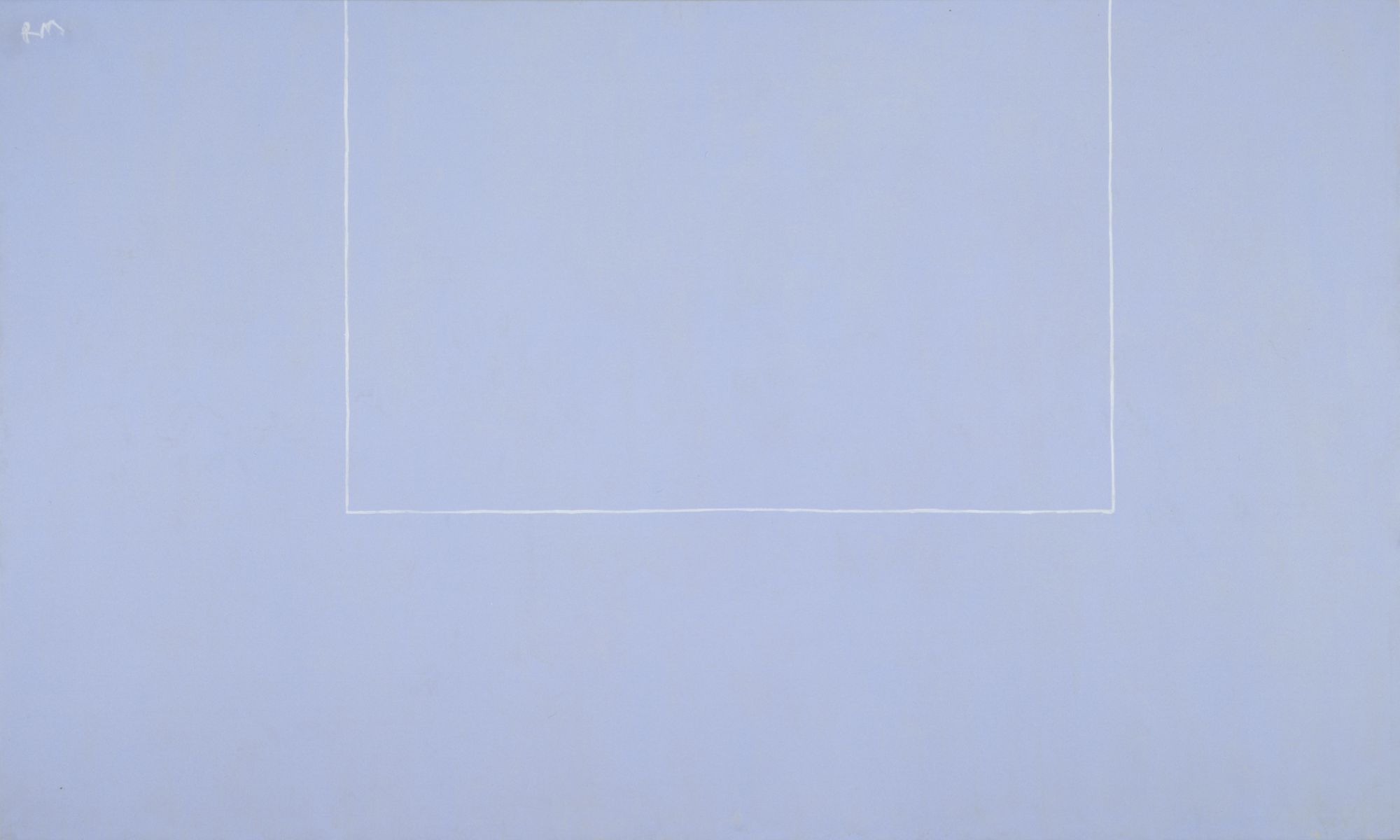
Open No. 15: In Cerulean Blue with White Line, 1968. Acrylic on canvas, 85 ½ x 143 ¾ inches (217.2 x 365.1 cm)
1968
Motherwell creates several large, austere paintings by the end of the summer as the Open series continues to develop.
In February, Motherwell writes to Tatyana Grosman at ULAE to propose a livre d’artiste using the poem “A la Pintura” by Rafael Alberti. Motherwell chooses to illustrate the book with imagery related to the new Open series, and ULAE printmaker Donn Steward suggests a combination of aquatint and sugar-lift etching to capture the rich color and hand-drawn lines of the paintings. Work commences in May and will continue for four years.
1958
During the Democratic National Convention in Chicago in August, Mayor Richard J. Daley orders the police to attack anti-war protestors. In response, 51 American painters and sculptors agree not to exhibit their work in the city for two years. Chicago gallerist Richard Feigen persuades them to participate in the exhibition Richard J. Daley, to protest the mayor’s actions.
Motherwell contributes Mural Sketch and Iberia No. 18 .
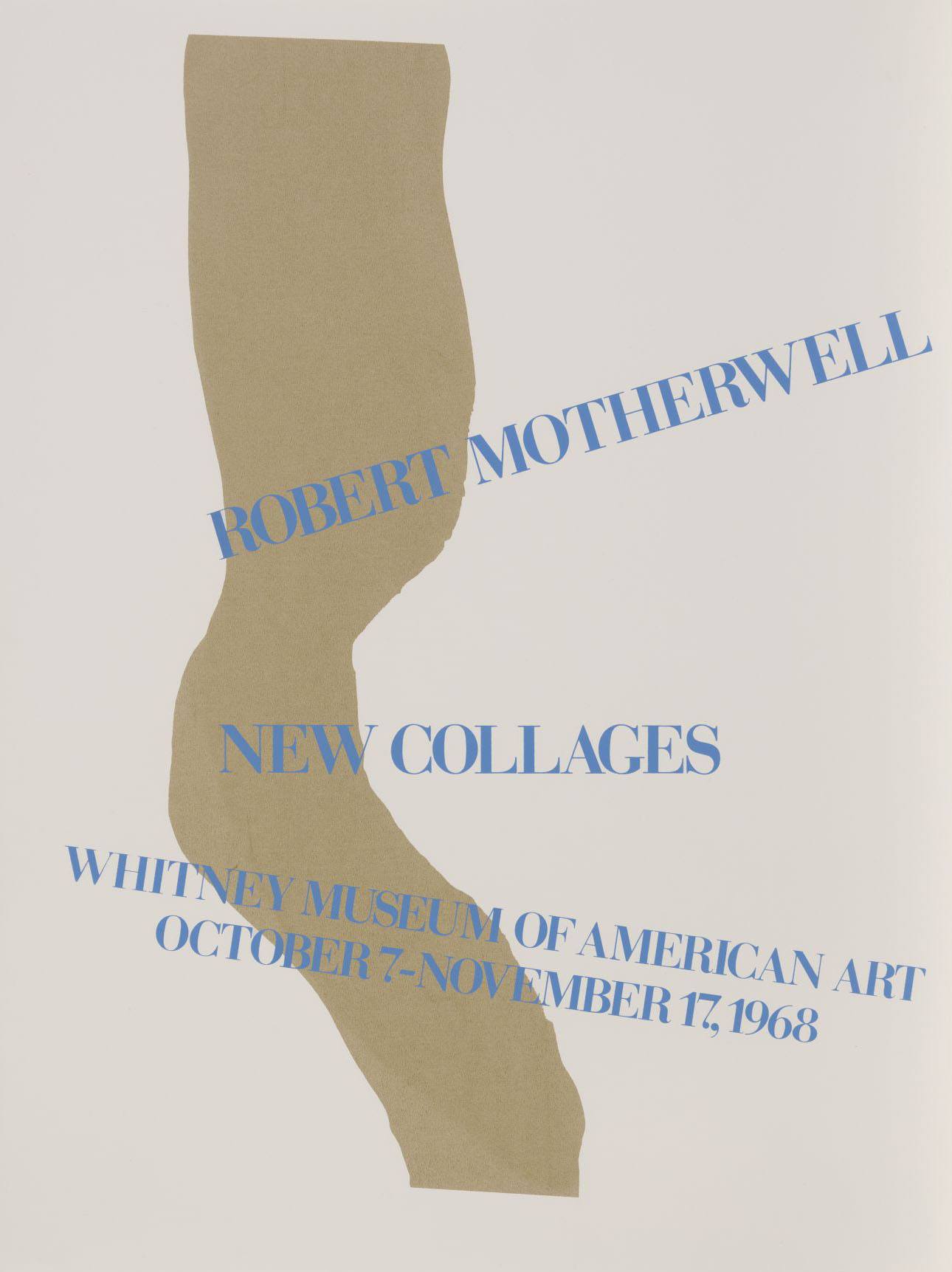
Exhibition poster from Robert Motherwell: New Collages at the Whitney Museum of American Art, New York, 1968
1968
In October and November, Robert Motherwell: Collages is shown at the Whitney Museum of American Art, presenting twenty-nine new collages from 1967–68.
1969
Motherwell continues preparations for the first exhibition of the new Open series at Marlborough-Gerson Gallery. By the end of April, he has completed forty-five large paintings and thirty smaller canvasses (approximately 24 by 36 inches) in the Open series. The series, which he had informally referred to as the “Window” series to this point, is officially named the “Open” series.
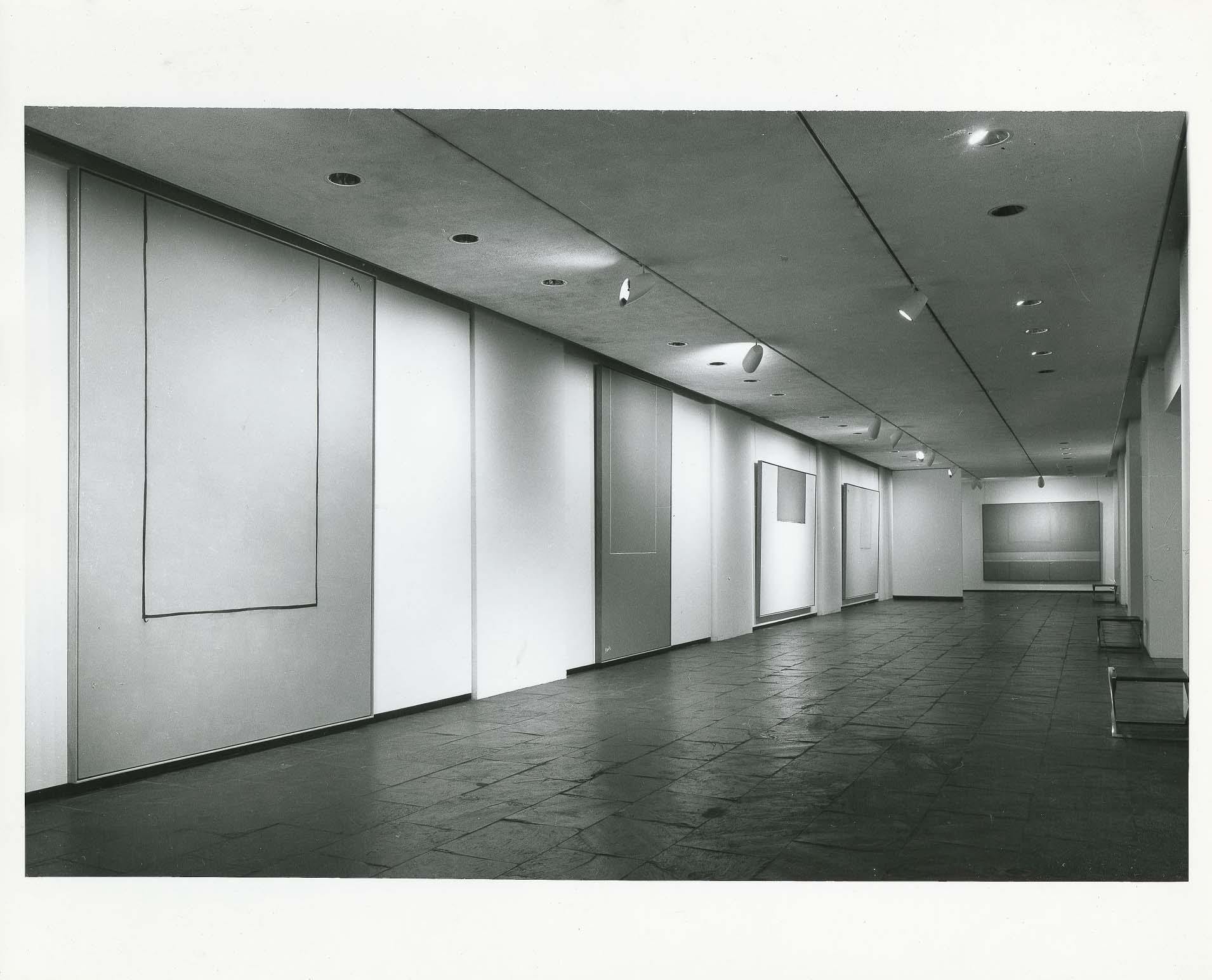
Installation view of Robert Motherwell: Open Series 1967–1969 at Marlborough-Gerson Gallery, New York, May 1969
1969
From May 13 to June 7, Robert Motherwell: Open Series 1967–1969 is shown at the Marlborough-Gerson Gallery. The exhibition features fourteen large new paintings, announcing a major new direction in Motherwell’s work.
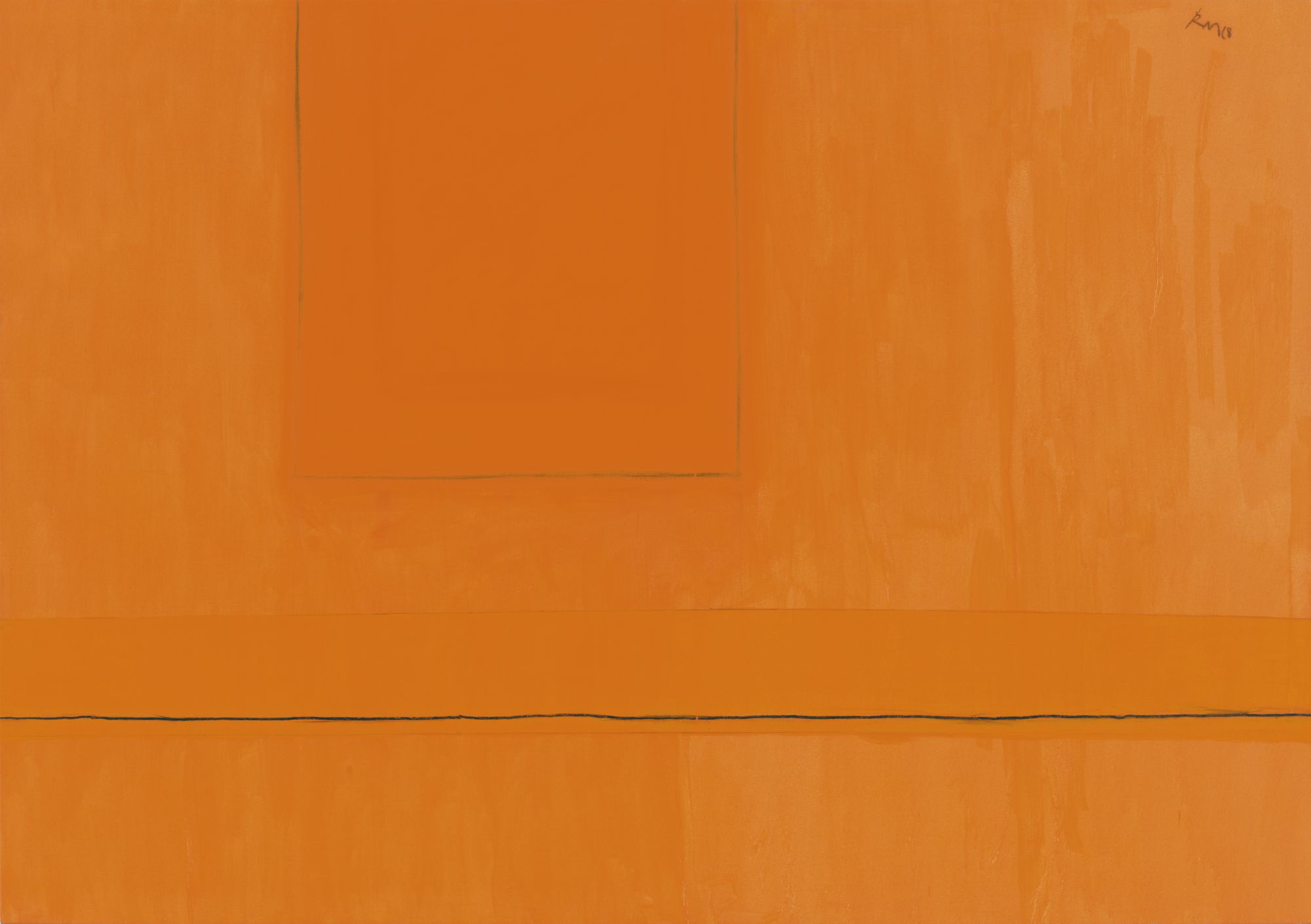
Open No. 24: In Variations of Orange, 1968. Acrylic and charcoal on canvas, 81 x 108 ¼ inches (205.7 x 275 cm)
1969
In June, The New American Painting and Sculpture: The First Generation, shown at the Museum of Modern Art, includes ten works by Motherwell, including the recent Open No. 24: In Variations of Orange.

Motherwell in his Provincetown, Mass. studio, summer 1969
1969
Motherwell’s production accelerates in the months following the exhibition of the Open series. In a two-year period, he creates forty-seven new large canvases, bringing the series total up to one-hundred and twenty-two paintings.
1969
In September, Robert Motherwell: Lyric Suite, an exhibition of thirty works from the series of ink on paper drawings created in 1965, is presented at the Museum of Modern Art. Motherwell completes a questionnaire on the works for the museum and his “Addenda to the Lyric Suite Questionnaire–from Memory…with Possible Chronological Slips” is published in the museum’s fall 1969 Members Newsletter.
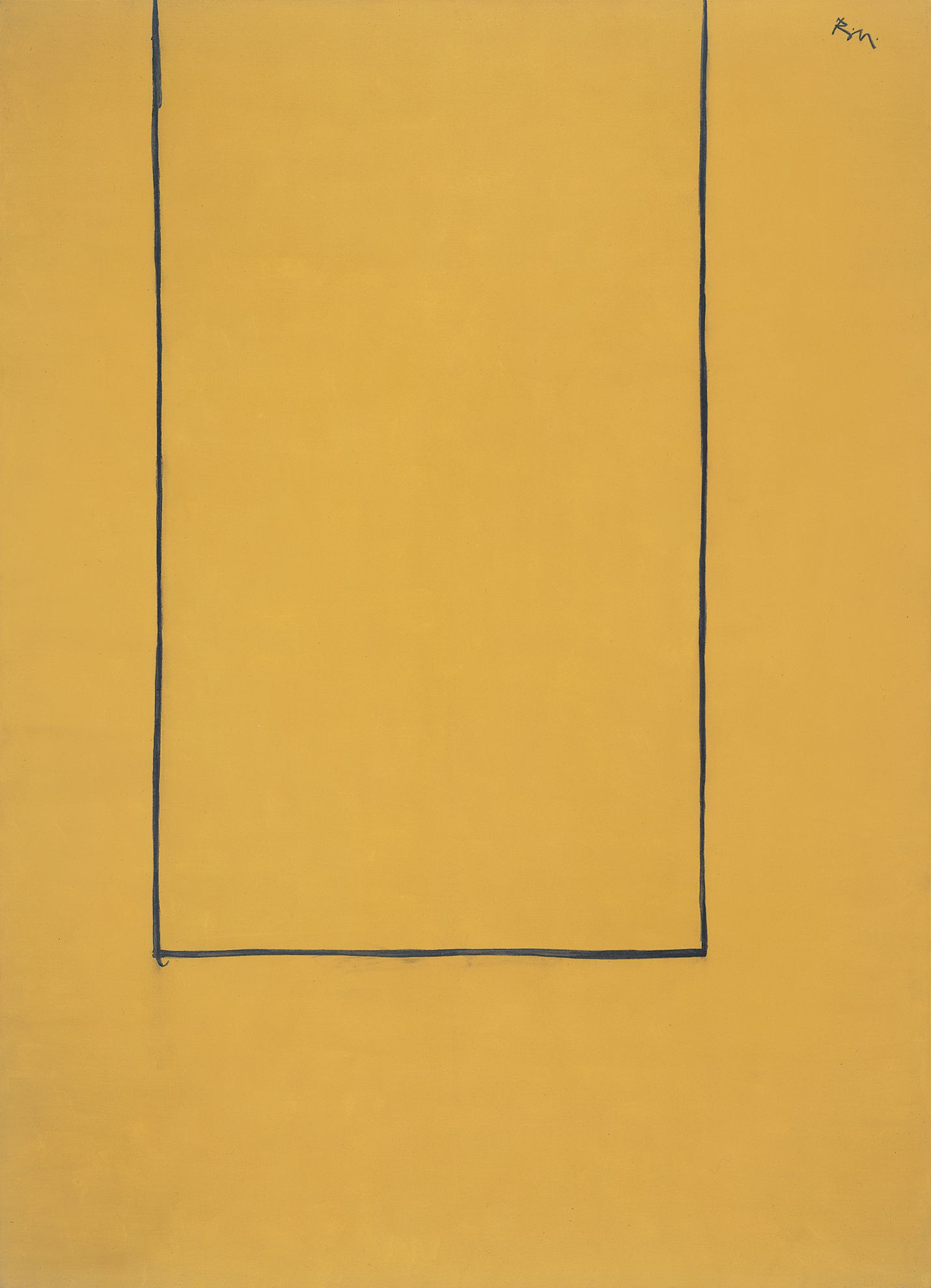
Open No. 14: In Ochre with Charcoal Line, 1967
1969
New York Paintings and Sculpture, 1940-1970 at the Metropolitan Museum of Art, opens in October. Organized by Henry Geldzahler, it includes twelve works by Motherwell, including Open No. 14: In Ochre with Charcoal Line.

Motherwell’s Greenwich, Conn., home and studio, ca. 1975
1970
Motherwell purchases an old carriage house in Greenwich, Connecticut.
At this time, his marriage to Frankenthaler is increasingly troubled.
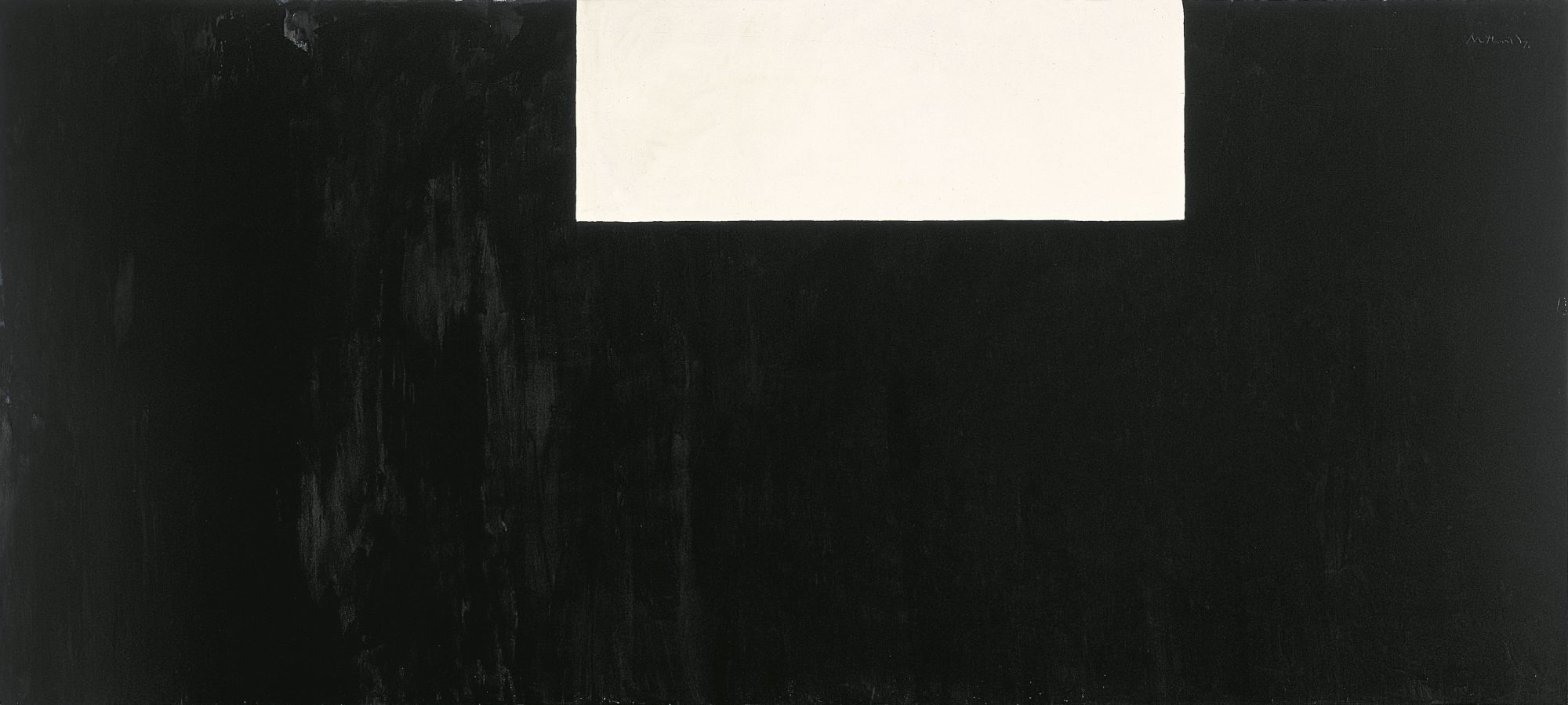
Open No. 150: In Black and Cream (Rothko Elegy), 1970. Acrylic on canvas, 69 x 204 ¼ inches (175.3 x 518.8 cm)
1970
Motherwell paints Open No. 150: In Black and Cream (Rothko Elegy) 1970 in honor of Mark Rothko, who committed suicide on February 25.
In May, Motherwell is inducted into the National Institute of Arts and Letters.
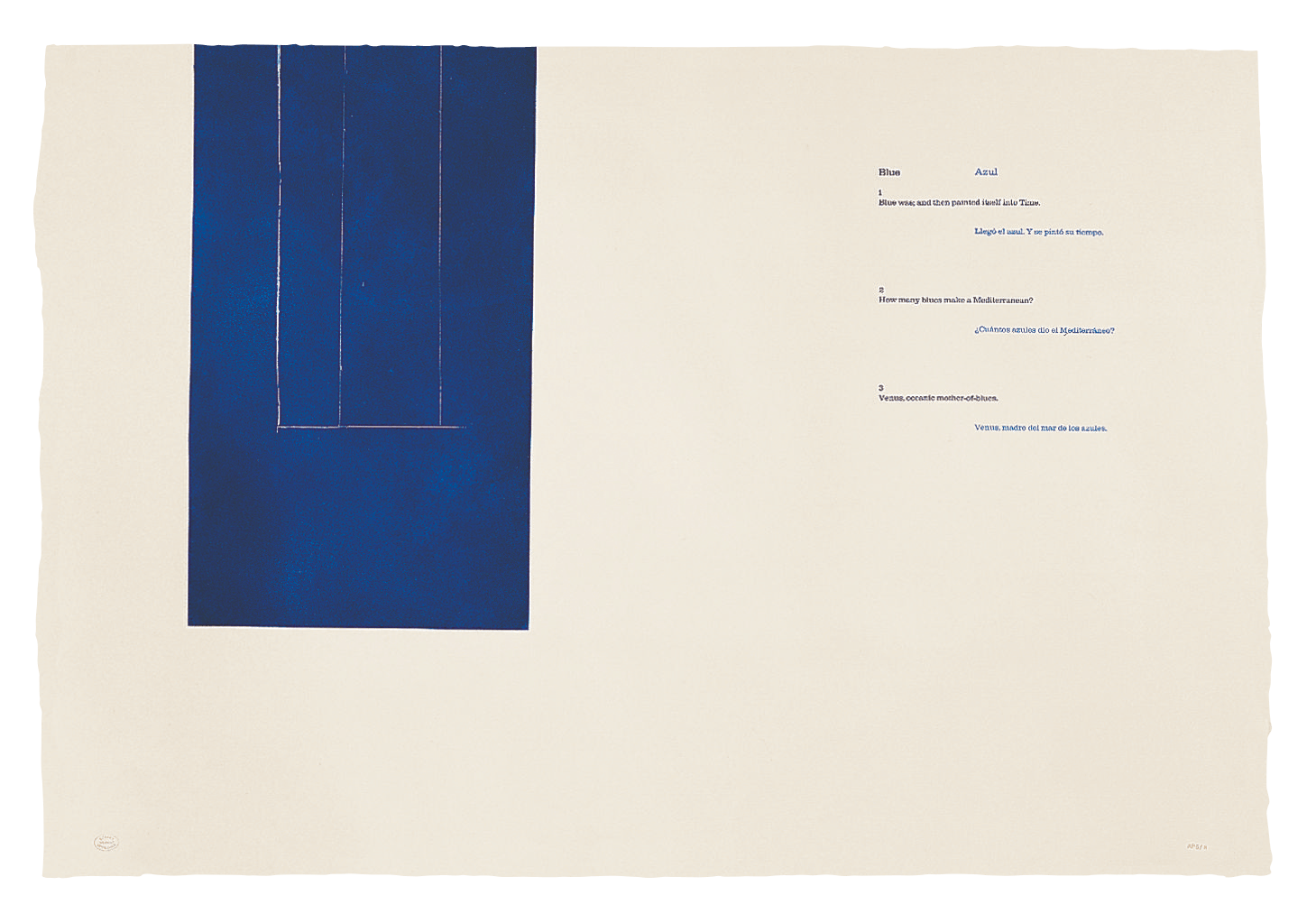
A la pintura: Blue No. 1-3, 1972
1970
During the last months of 1970, Motherwell divides his time between New York and Greenwich, where the carriage house is undergoing renovations, and continues to work at ULAE on A la Pintura.
1970
Around Christmas, Motherwell and Frankenthaler separate. She soon files for divorce.
1971
The first two volumes of the Documents of 20th-Century Art are published by Viking Press: Dialogues with Marcel Duchamp, edited by Pierre Cabanne, with an introduction by Motherwell, and My Galleries and Painters by Daniel-Henry Kahnweiler.
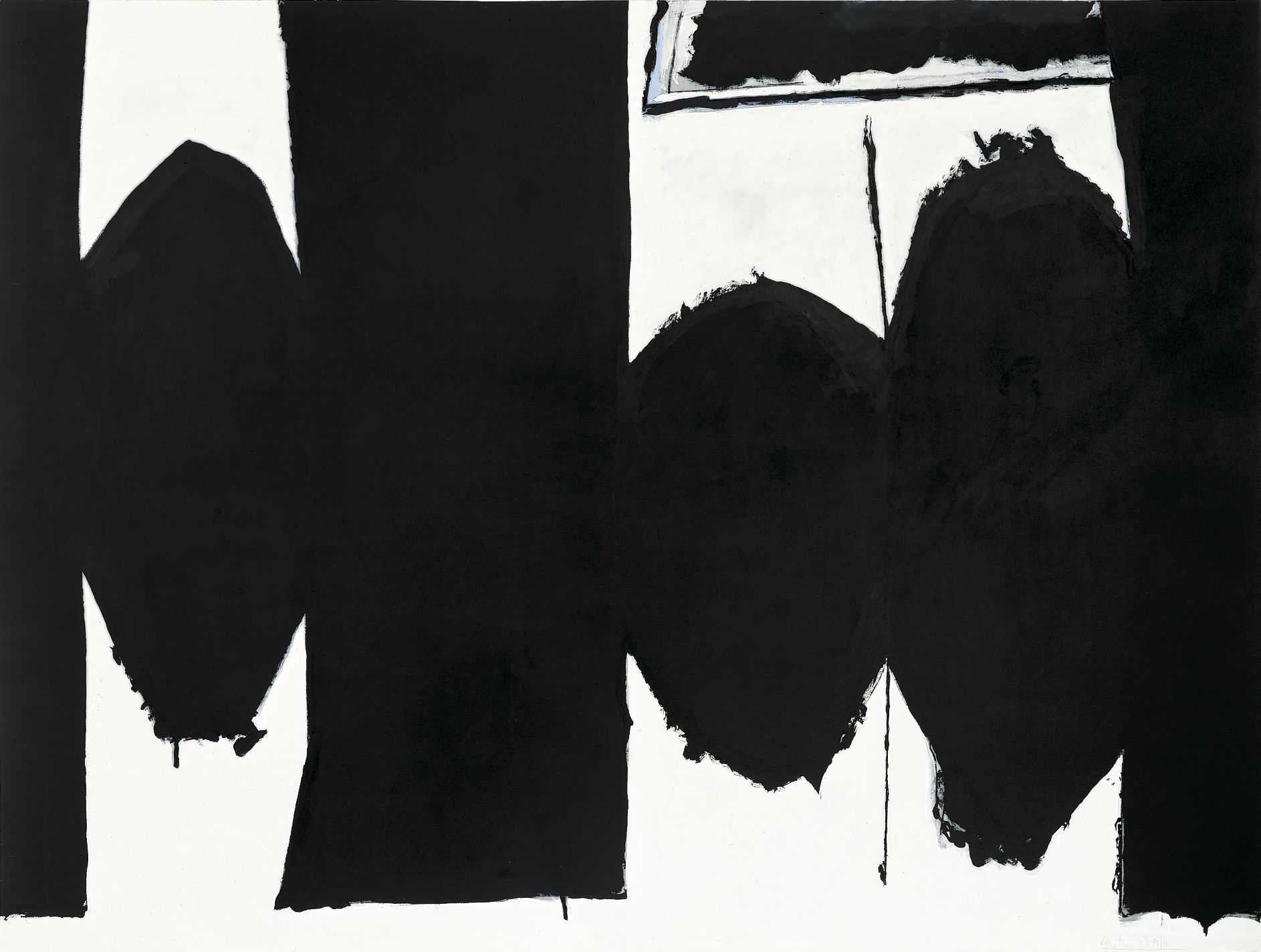
At Five in the Afternoon, 1971
1971
Motherwell and Frankenthaler’s divorce is finalized on June 15.
During the summer, Motherwell returns to Provincetown. Knowing that he will be losing the early painting At Five in the Afternoon to Frankenthaler in the divorce, Motherwell paints a large version of it.
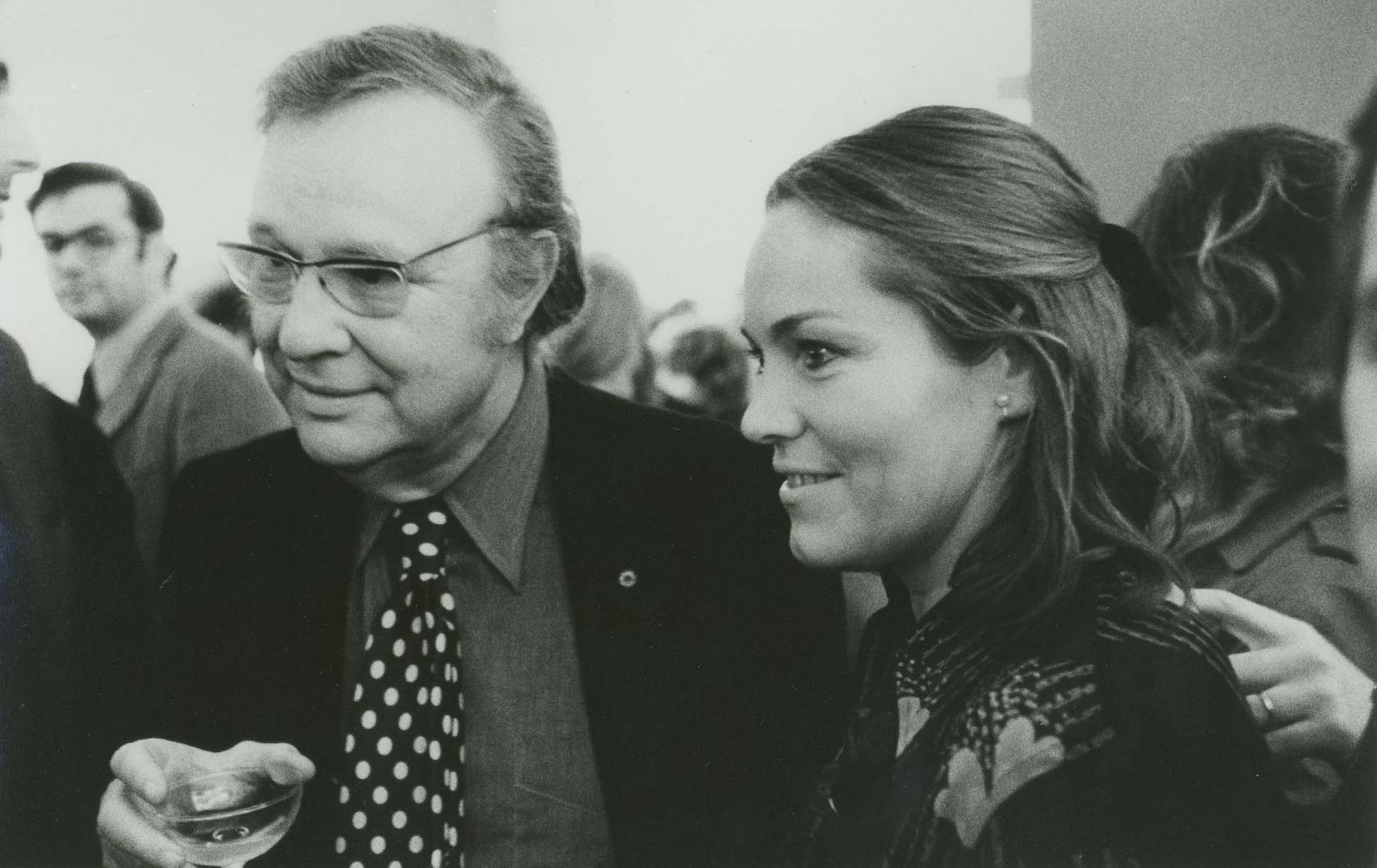
Motherwell with Renate Ponsold at Fendrick Gallery opening, November 1972
1971
In the fall, Motherwell begins living in Greenwich full-time.
Soon after, he meets the German photographer Renate Ponsold, who he will marry the following year.
1971
Motherwell accepts an appointment as a Distinguished Professor at Hunter College for the academic year 1971—72.
Ulfert Wilke, Director of the University of Iowa Art Museum, proposes a mural commission to Motherwell. Wilke visits in October and they agree that Motherwell will paint a new, large Elegy to the Spanish Republic painting.
1972
In January, Motherwell gives the Marlborough-Gerson gallery notice that he is terminating his contract with them, effective June 1. He had been with the gallery for nine years.
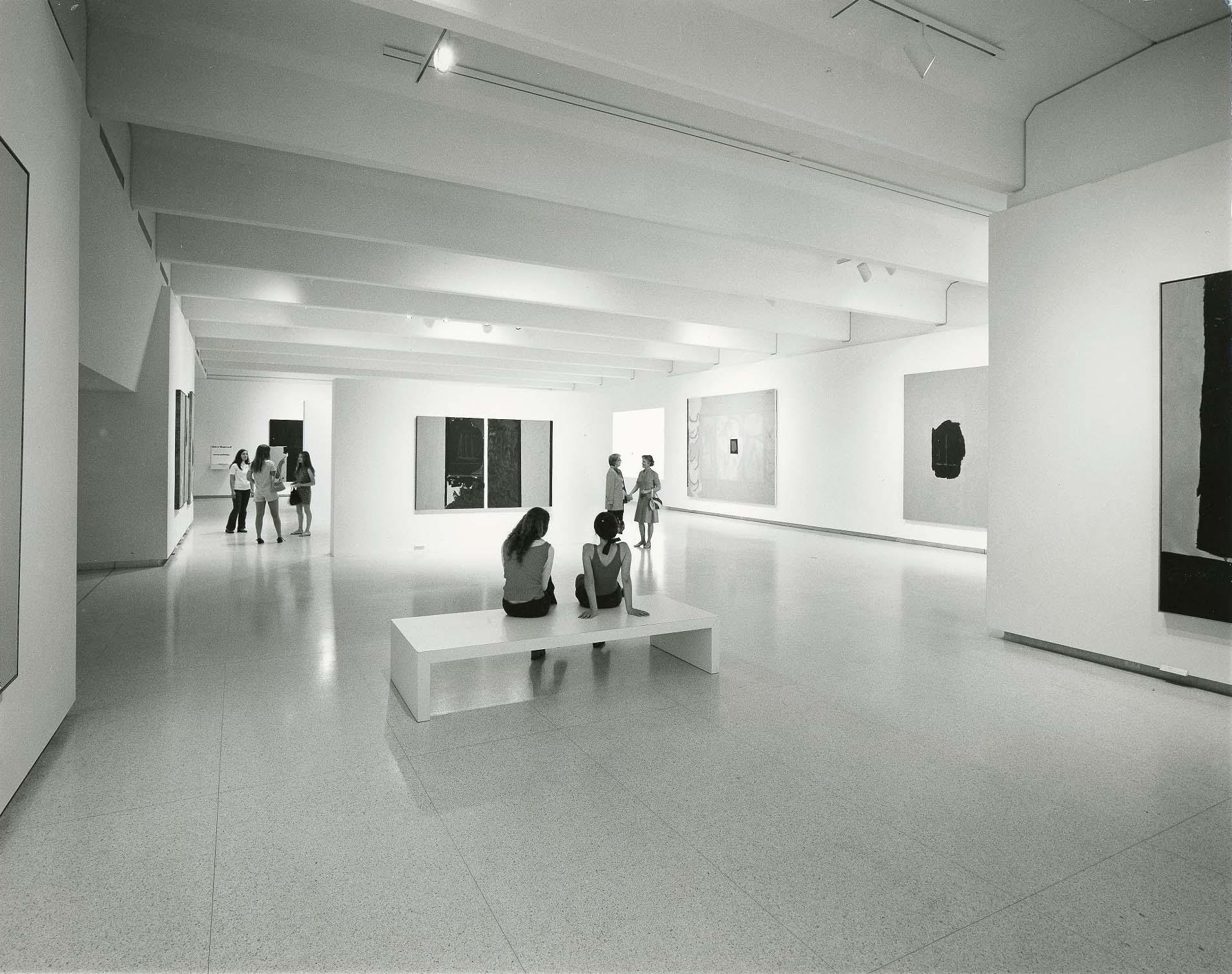
Installation view of Robert Motherwell: Recent Paintings at the Walker Art Center, Minneapolis, 1972
1972
Over the summer, Robert Motherwell: Recent Paintings, curated by Martin Friedman, is shown at the Walker Art Center, Minneapolis. The exhibition presents sixteen paintings from the summer of 1971. On August 6, Motherwell participates in a public interview with Friedman and Dean Swanson.
1972
During the summer, Motherwell works on the Gauloises series of collages, sixty-one unique variations on Gauloises with Scarlet.
1972
Motherwell’s mother, Margaret Rosener dies in Palo Alto, California on July 1.
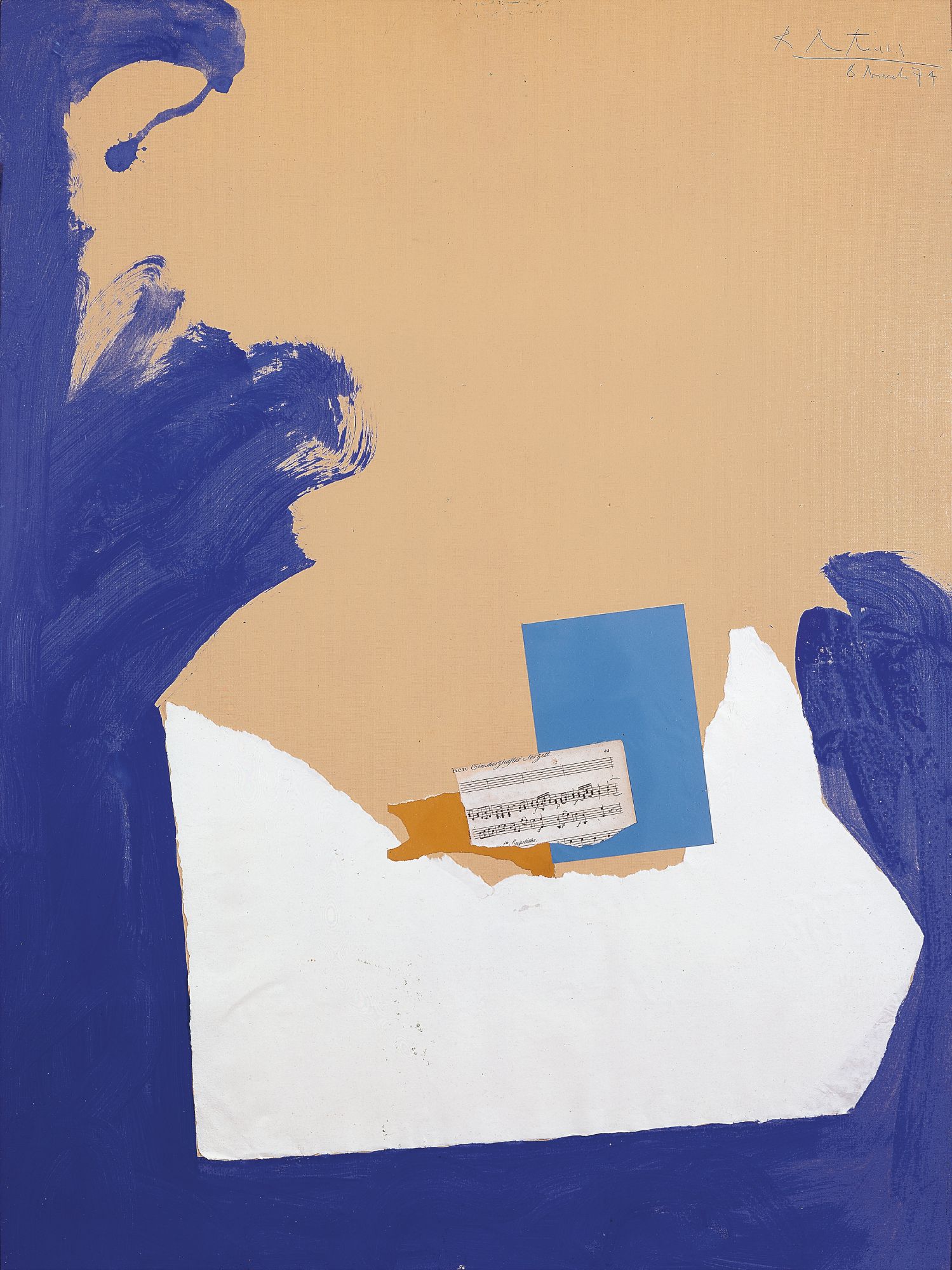
The Baltic Sea Bride No. 1, 1974. This collage was inspired by Motherwell’s wife Renate Ponsold.
1972
Motherwell marries Renate Ponsold in Provincetown on August 16.
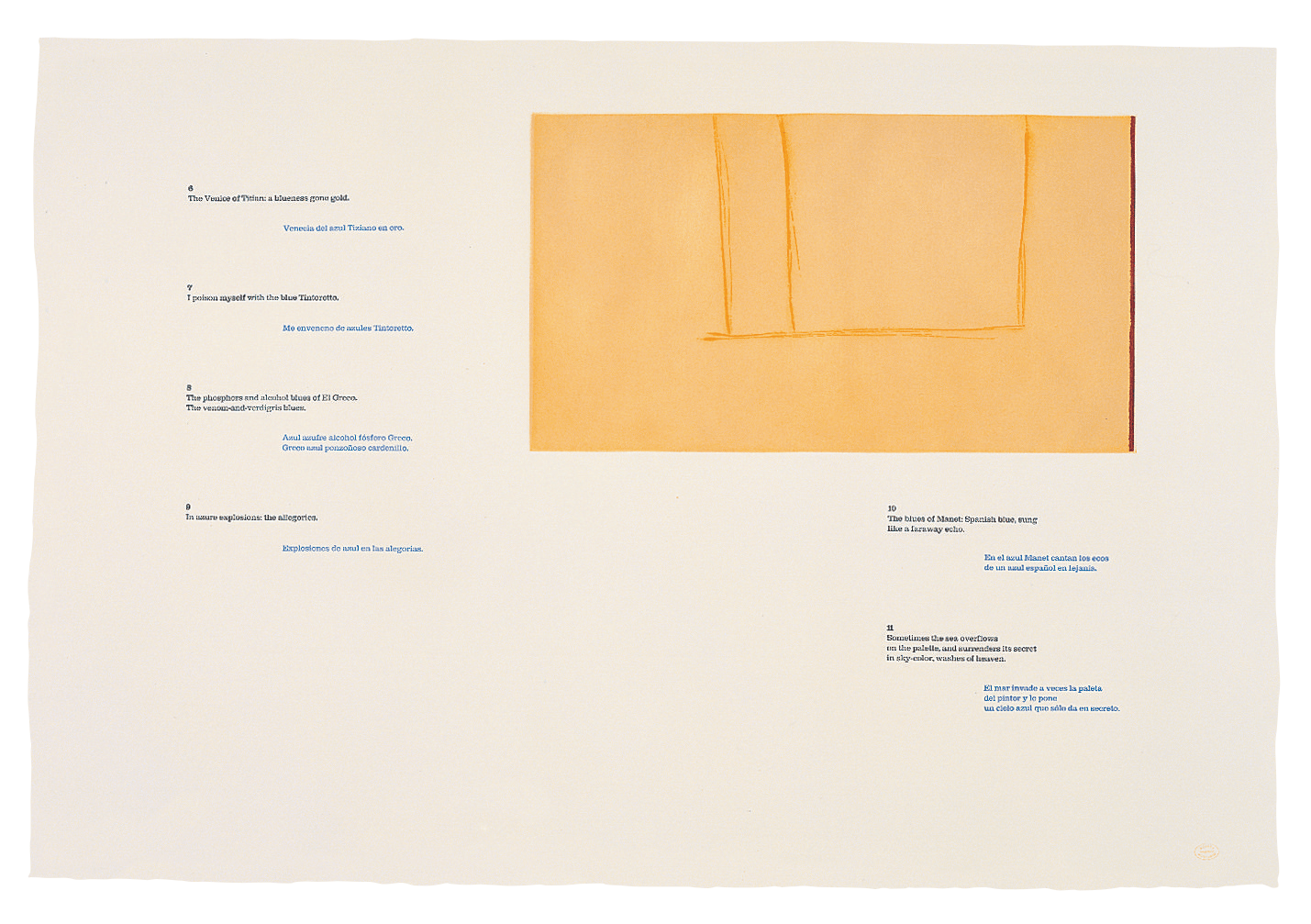
A la pintura Blue 6-11, 1972
1972
In September, A la pintura is published by ULAE in an edition of forty, after four years of work by Motherwell.
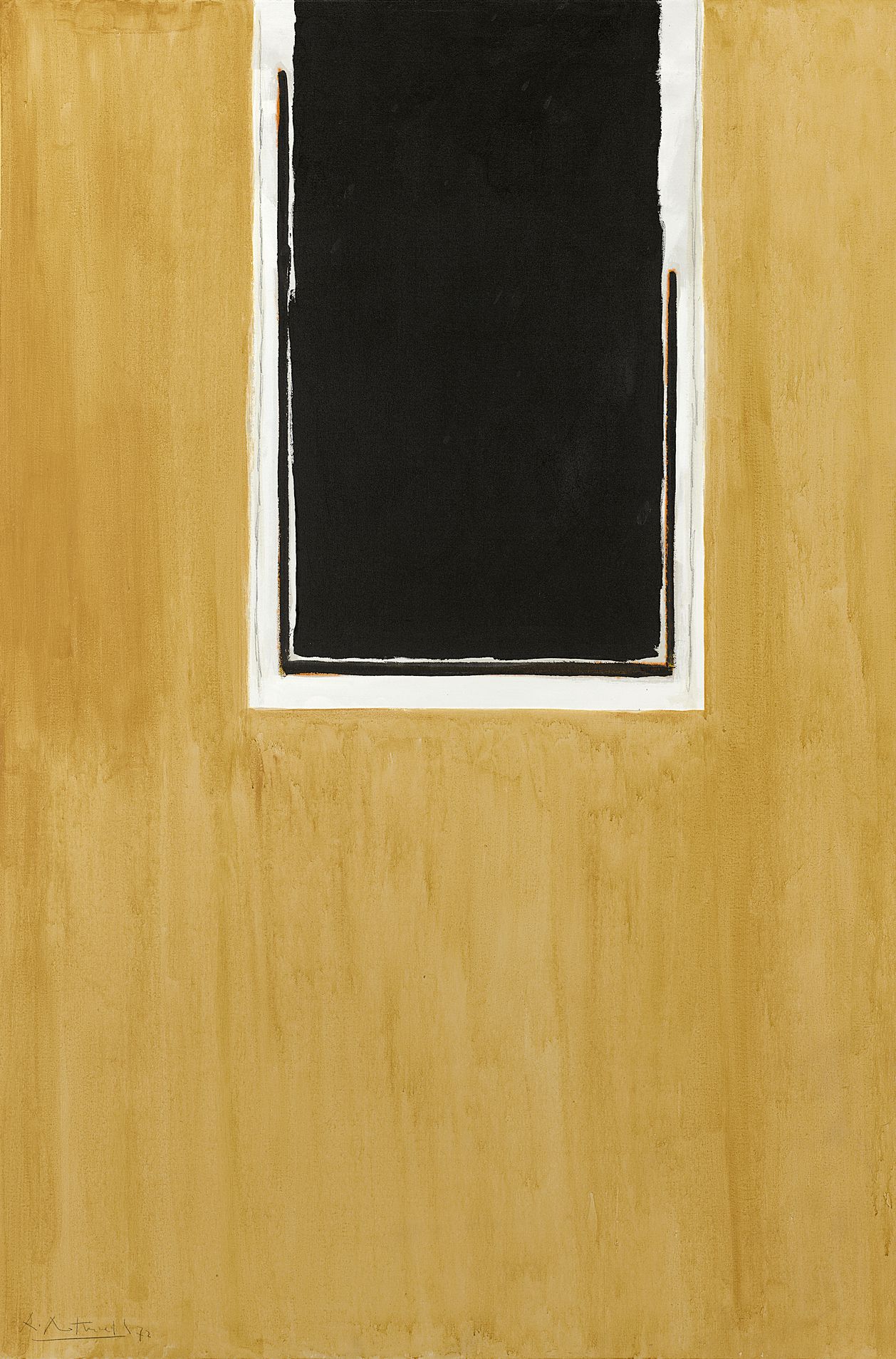
The August Sun and Shadow, 1972
1972
In the fall, Motherwell’s first exhibition with the Lawrence Rubin Gallery includes nine recent paintings, including The August Sun and Shadow.
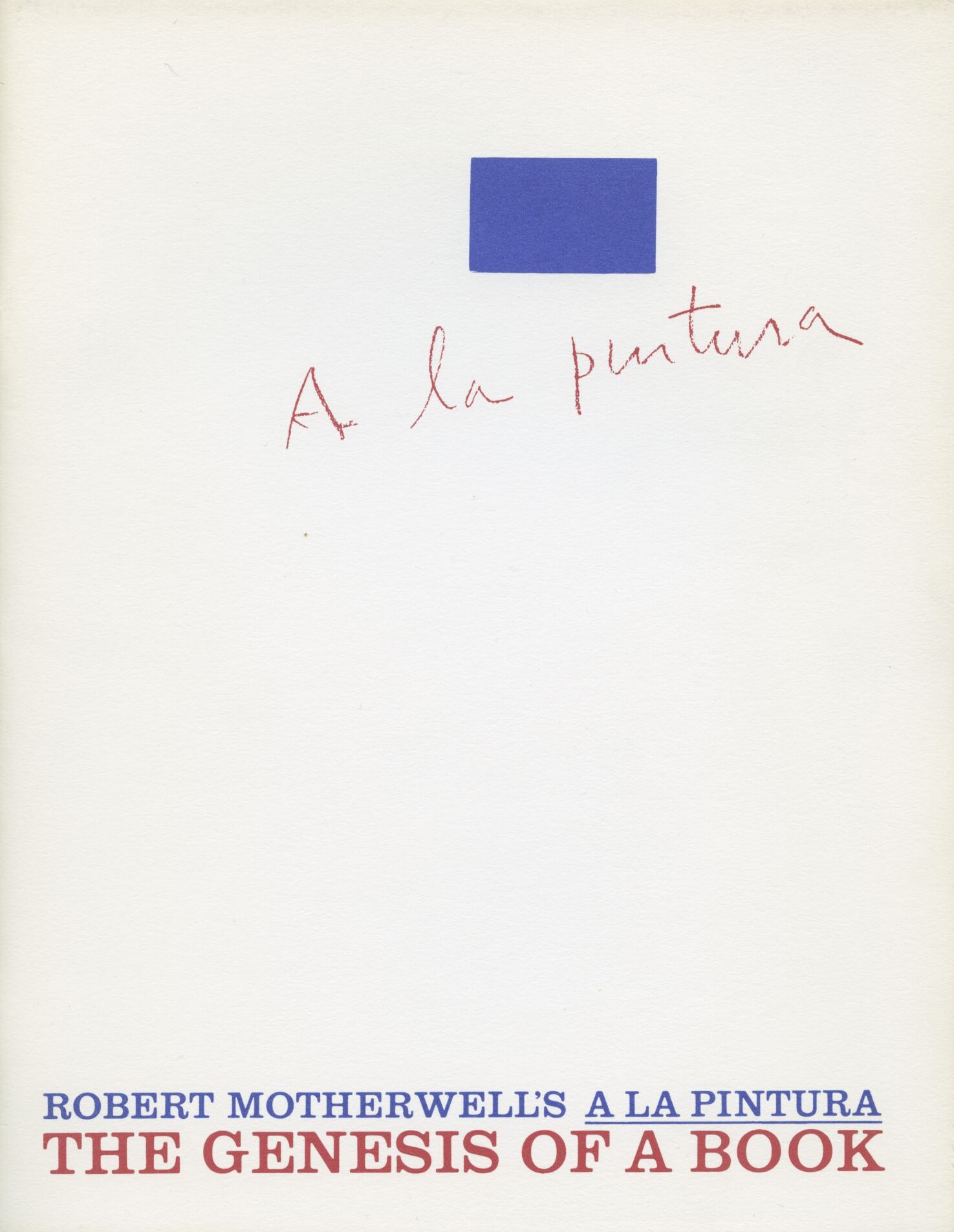
Cover of the catalogue for A la Pintura, Metropolitan Museum of Art, New York, 1972
1972
In the fall, A la Pintura is shown at the Metropolitan Museum of Art. A catalogue with essays by Motherwell and curator John McKendry, accompanies the show.
1972
In November, The Collages of Robert Motherwell: A Retrospective Exhibition, organized by E.A. Carmean Jr., opens at the Museum of Fine Arts, Houston. The exhibition includes forty-one works dating from 1943 to 1972. It travels to Cleveland, Hartford, and Boston.
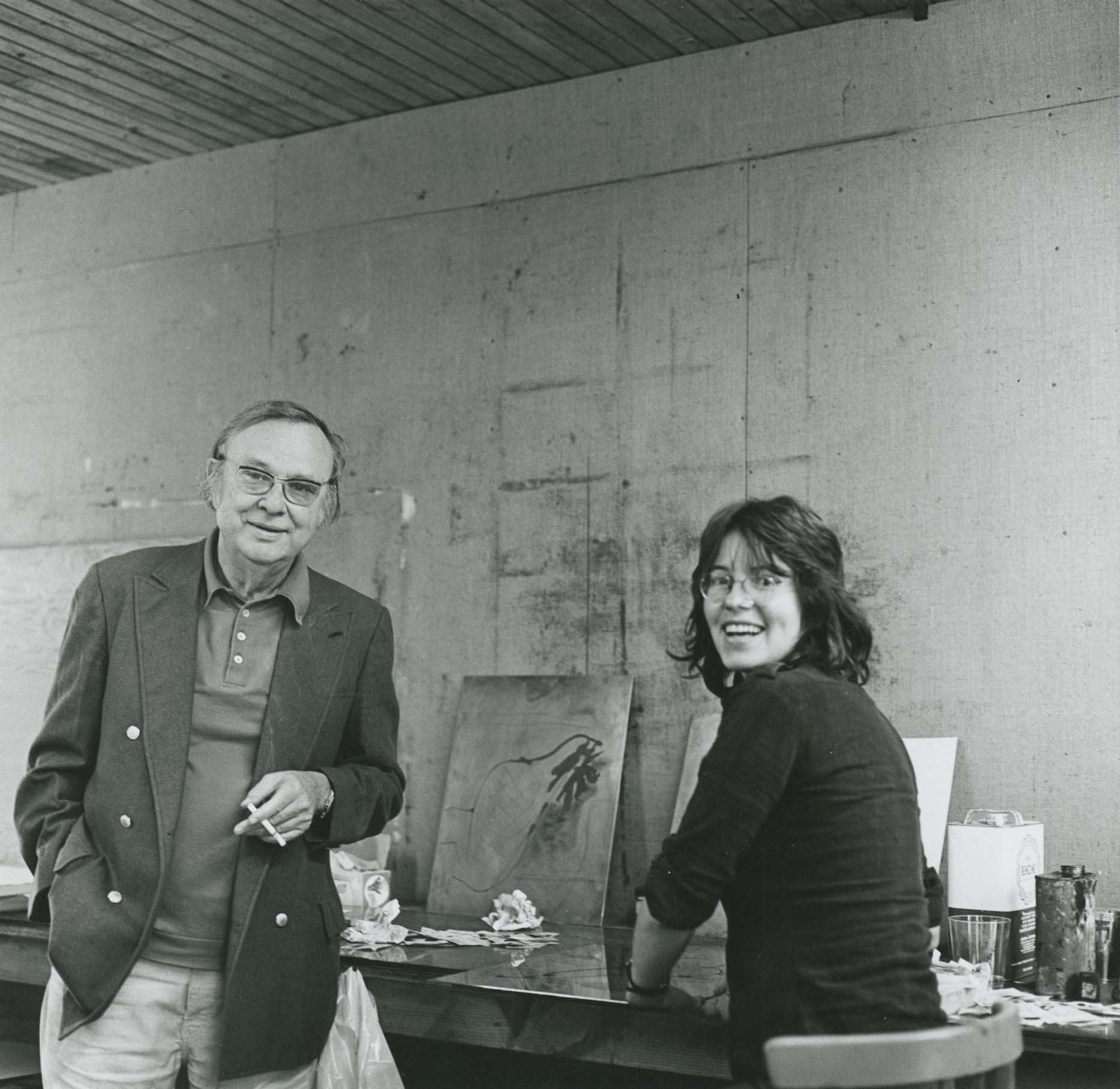
Motherwell and Catherine Mosley in his Greenwich studio, November 1973
1973
Motherwell establishes his own print workshop in Greenwich. He buys a Brand etching press, hires printmaker Catherine Mosley, and begins publishing his own editions.
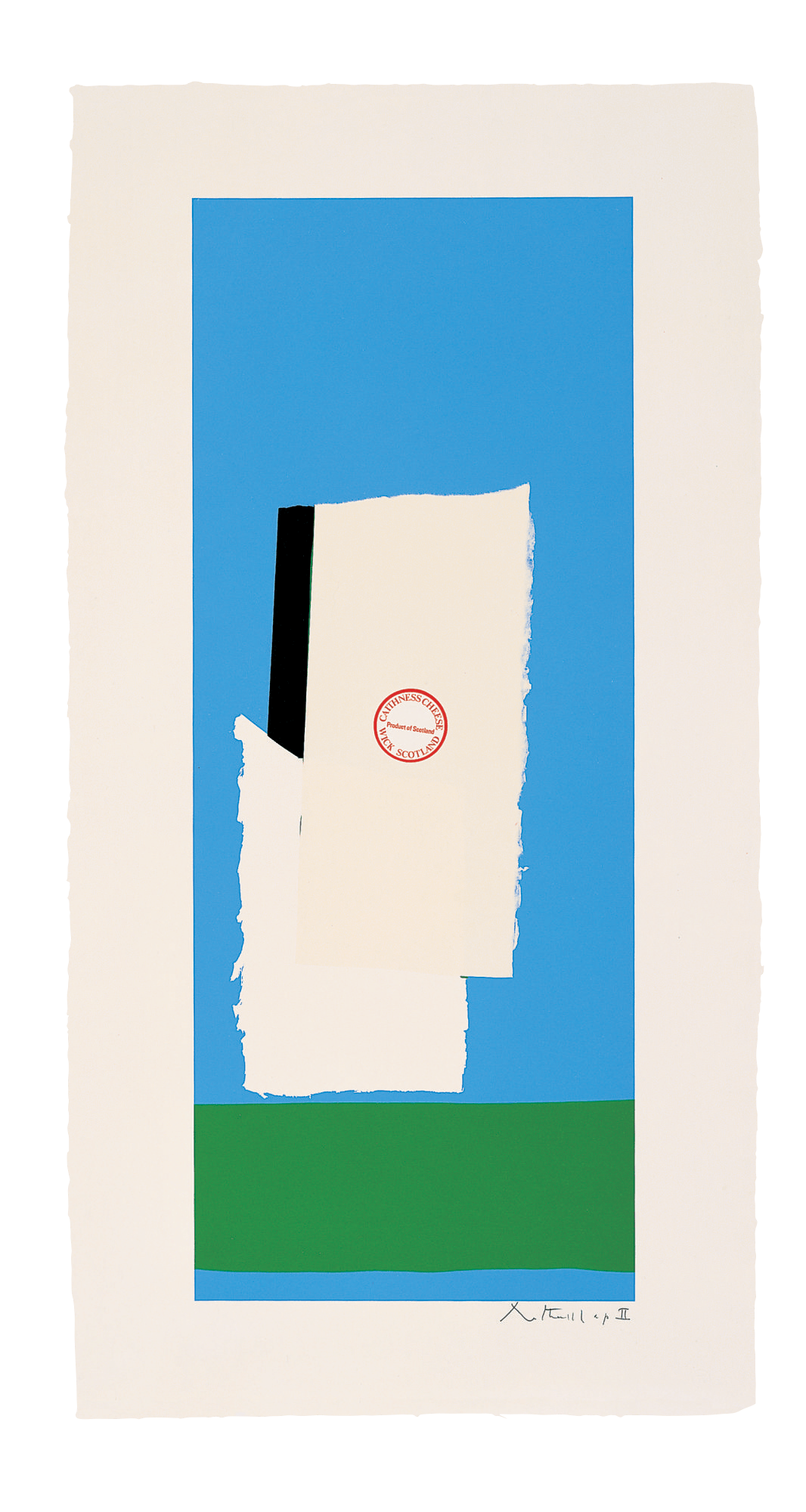
Summer Light Series: The Highlands, 1973
1973
Motherwell also works with Kenneth Tyler at Gemini G.E.L., Los Angeles, producing lithographic editions that include the Summer Light series and the Soot Black Stone series.
For the first time, he incorporates lithographic reproductions of labels and cigarette packages in his collages.
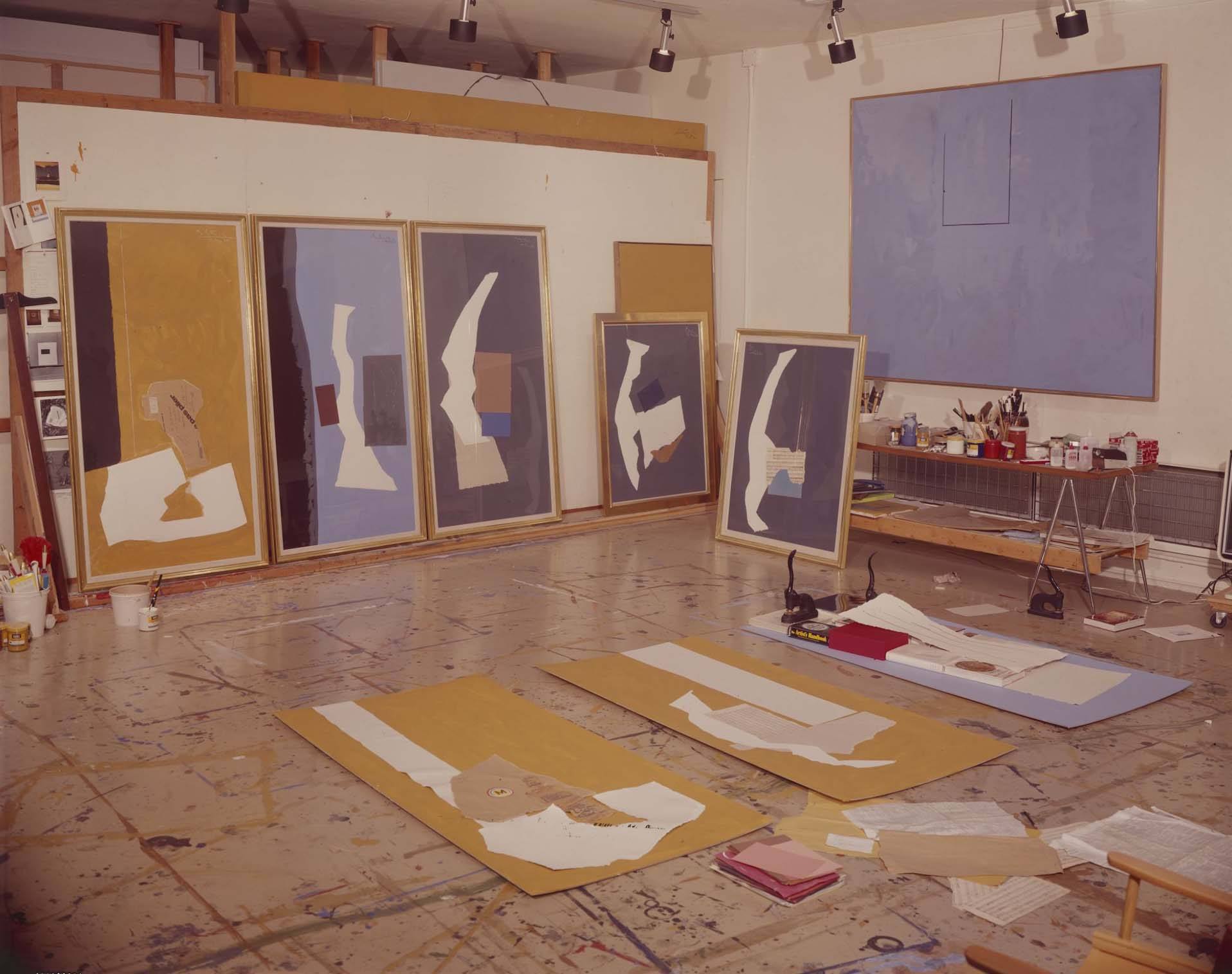
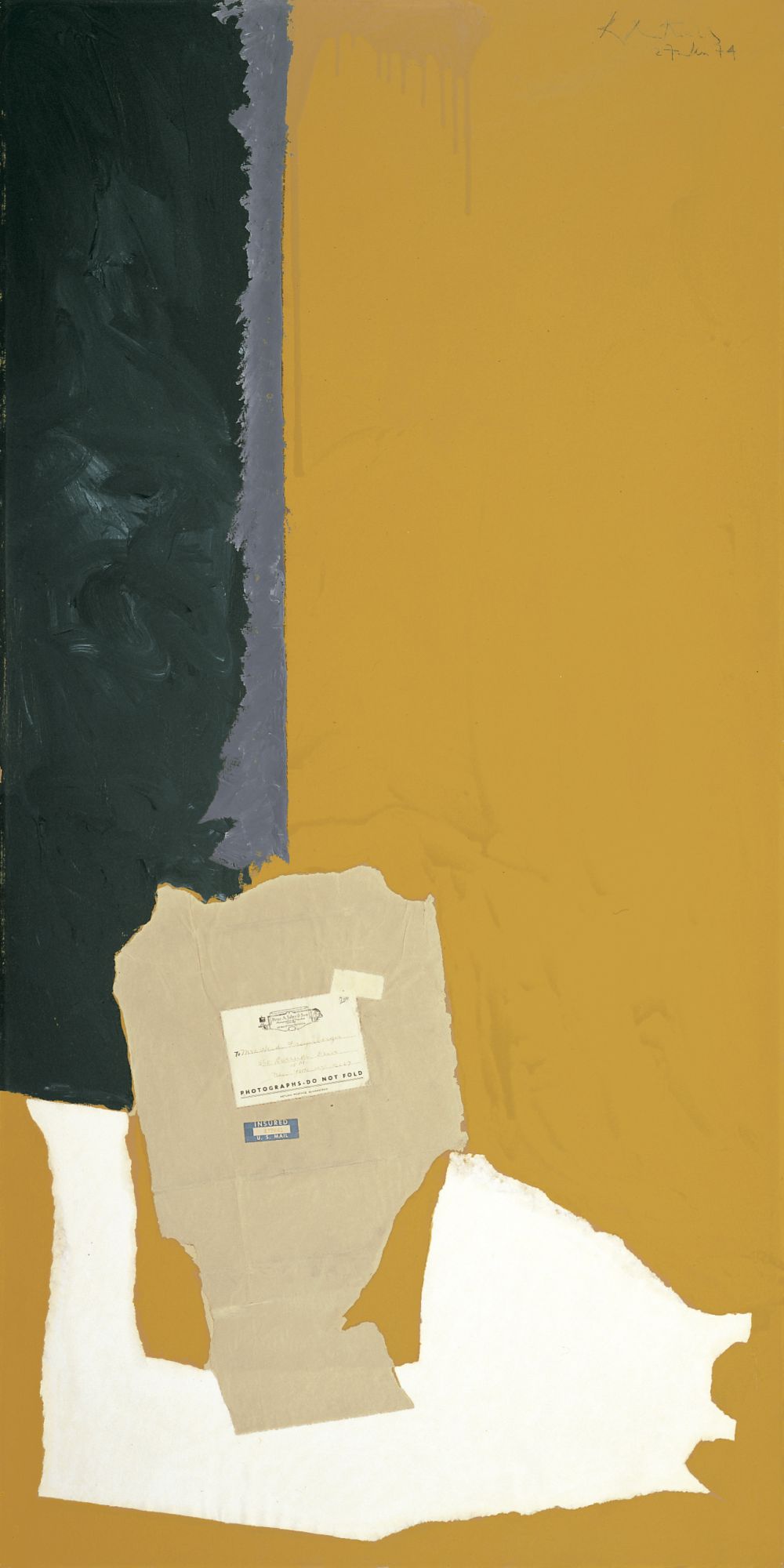
1974
Motherwell works on a number of large collages, beginning with Heidi and Claus, which measures 72 by 36 inches. These new works introduce a vocabulary of torn canvas, artist’s papers, and printed elements on a scale not previously seen in his collages.
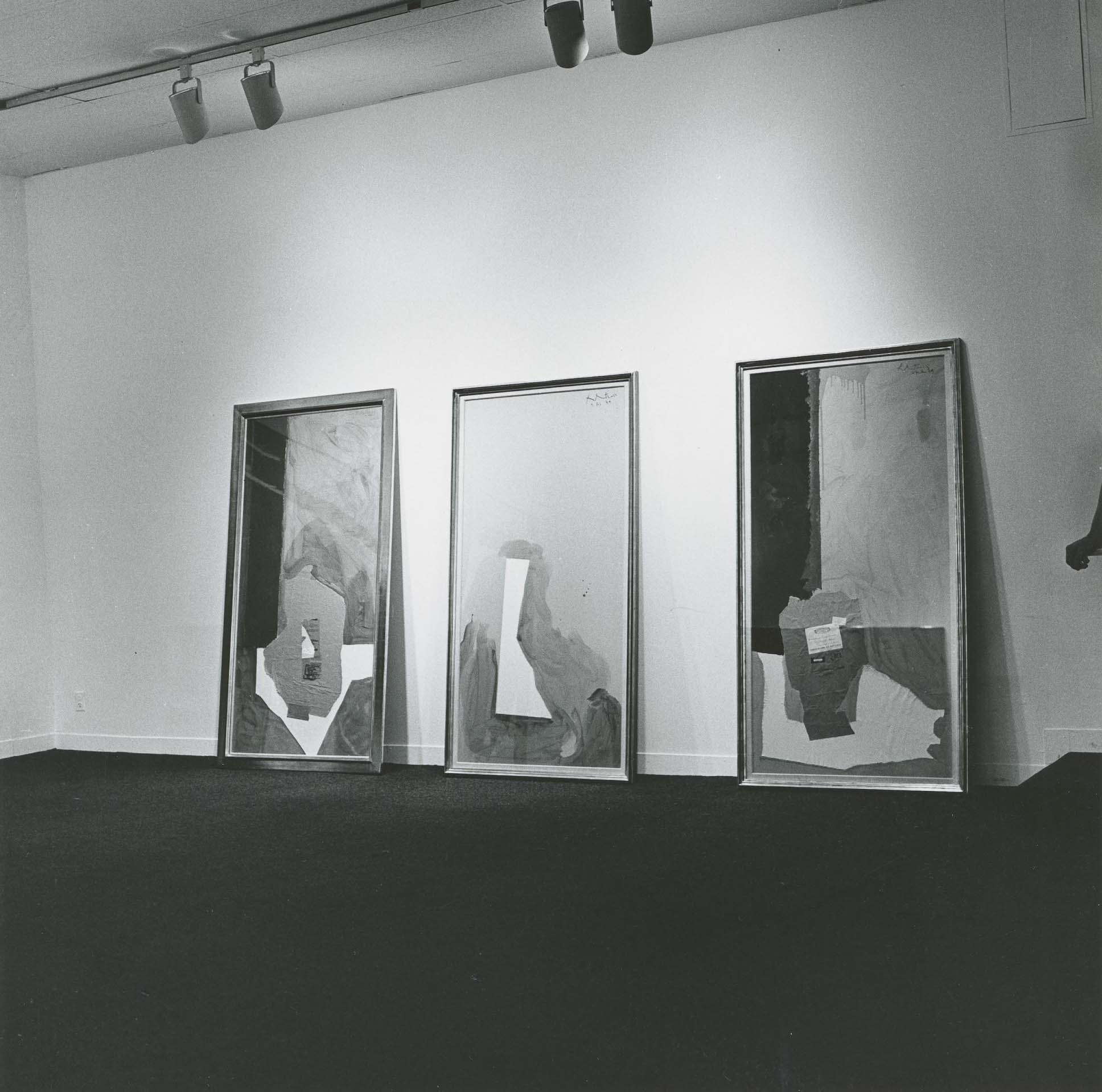
Installation view of Robert Motherwell: Recent Paintings and Collages at Knoedler Contemporary Art, New York, April 1974. From left to right: Ambiguity of Space, Beckett’s Space, and Heidi and Claus
1974
In April, Robert Motherwell: Recent Paintings and Collages is presented at Knoedler Contemporary Art Gallery, New York. The gallery is a new partnership between the Knoedler Gallery and Lawrence Rubin and will become Motherwell’s principal gallery for the rest of his life. This first exhibition at the gallery includes Elegy to the Spanish Republic No. 124, In Plato’s Cave No. 1, and Motherwell’s recent large collages, including Heidi and Claus.
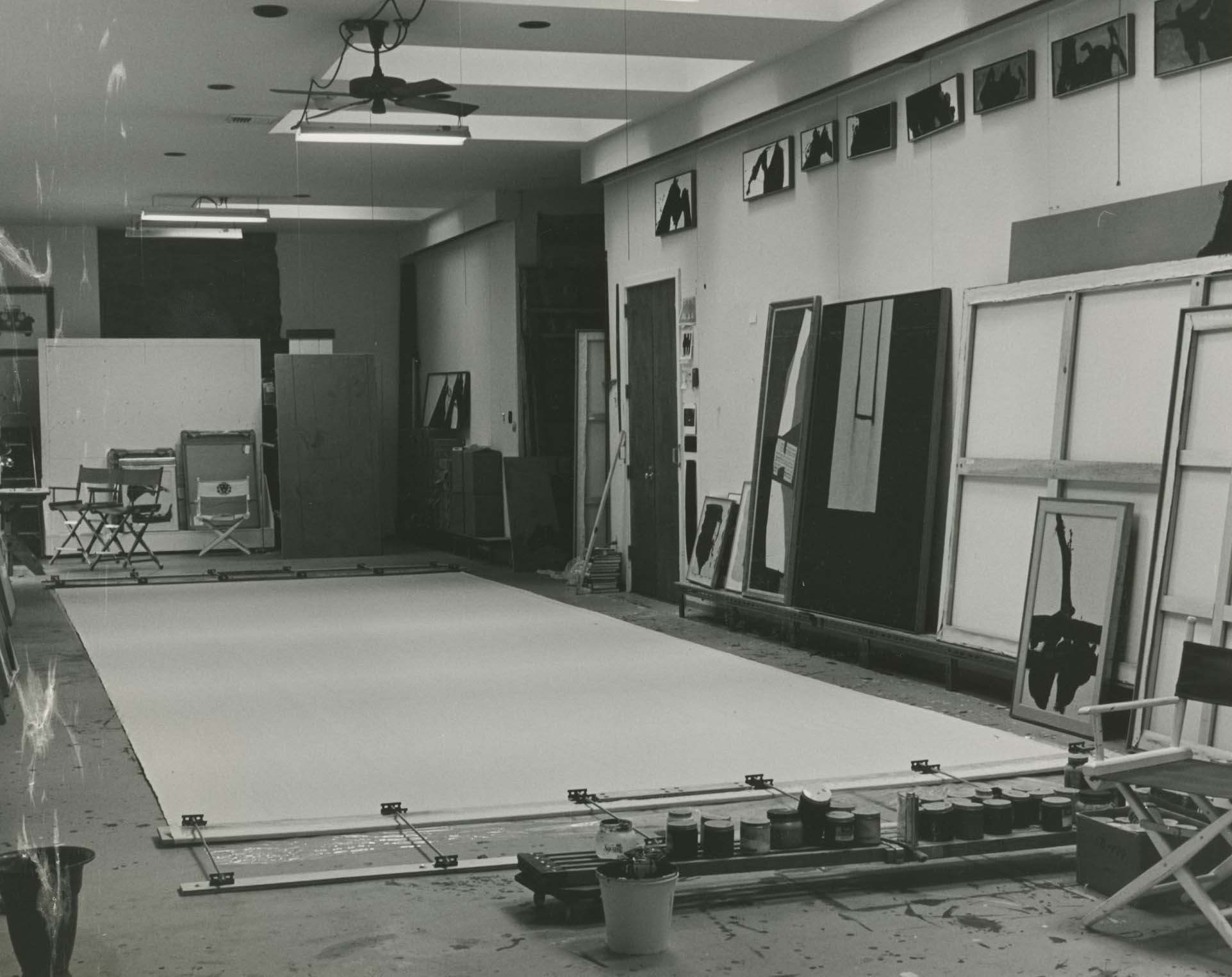
Motherwell’s Greenwich studio
1974
That summer, Motherwell has a new studio built in Greenwich, which provides a large, loft-like space for painting.
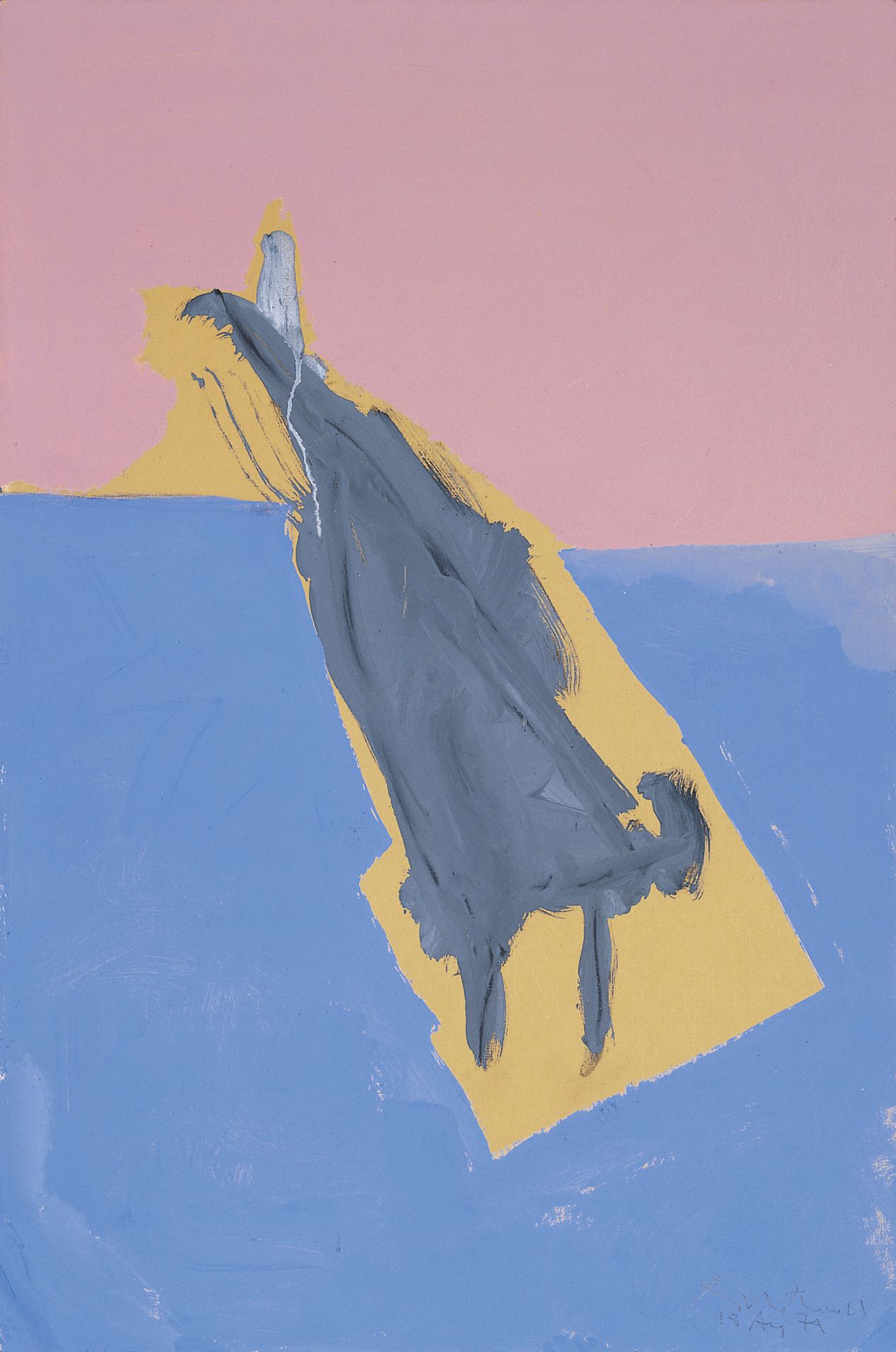
The Wild Duck, 1974
1974
In June, Motherwell suffers from an acute attack of pancreatitis and is hospitalized for several weeks; surgery is scheduled for the fall.
In Provincetown that summer, he paints as though each day could be his last, creating thirty works in sixty days, including the Persian series and The Wild Duck.
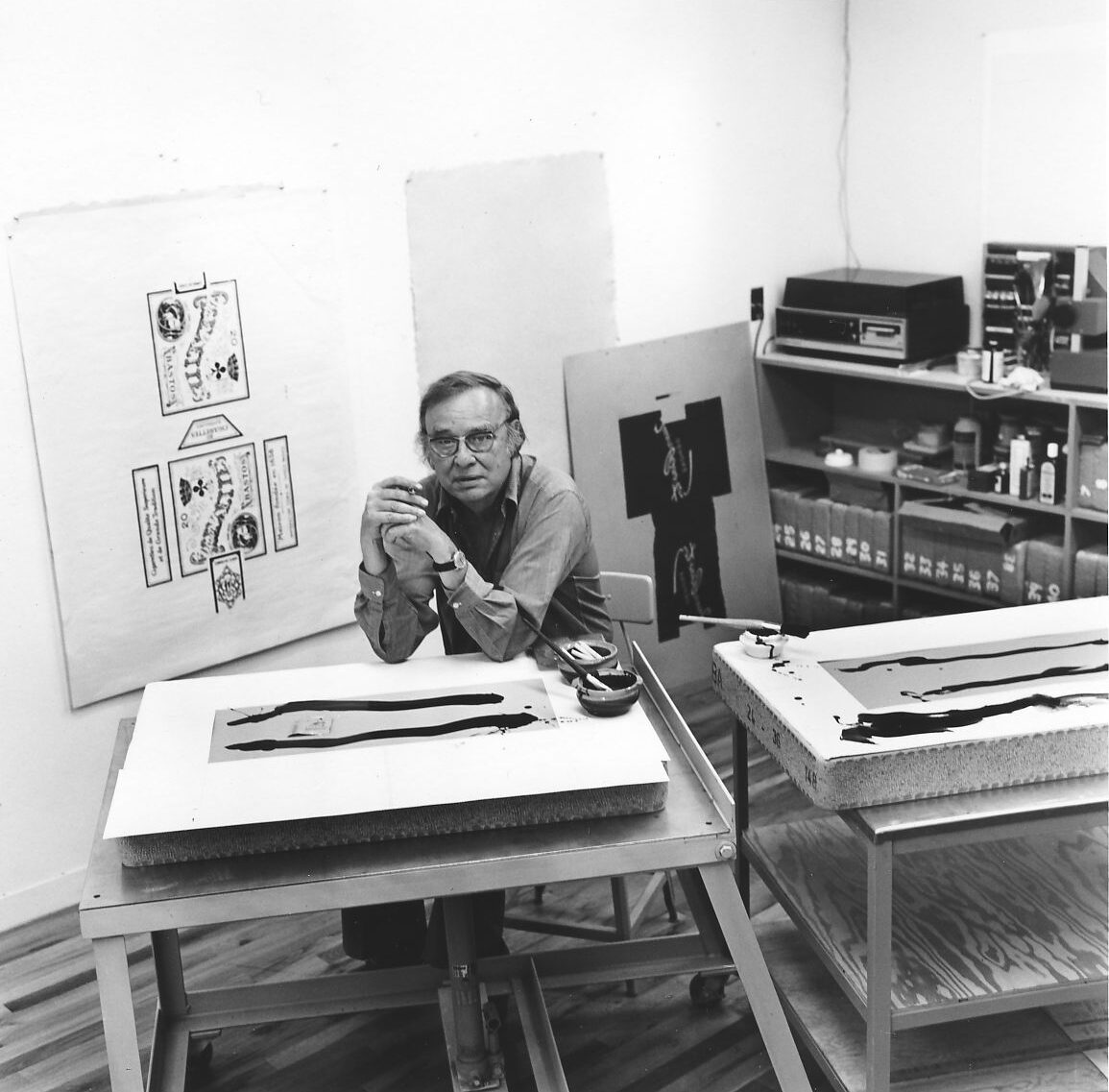
Motherwell working at Tyler Graphics, fall 1974
1974
In September, Motherwell begins work on his first prints at Kenneth Tyler’s newly opened workshop, Tyler Graphics Ltd., in Bedford, New York, just a short drive from his home in Greenwich.
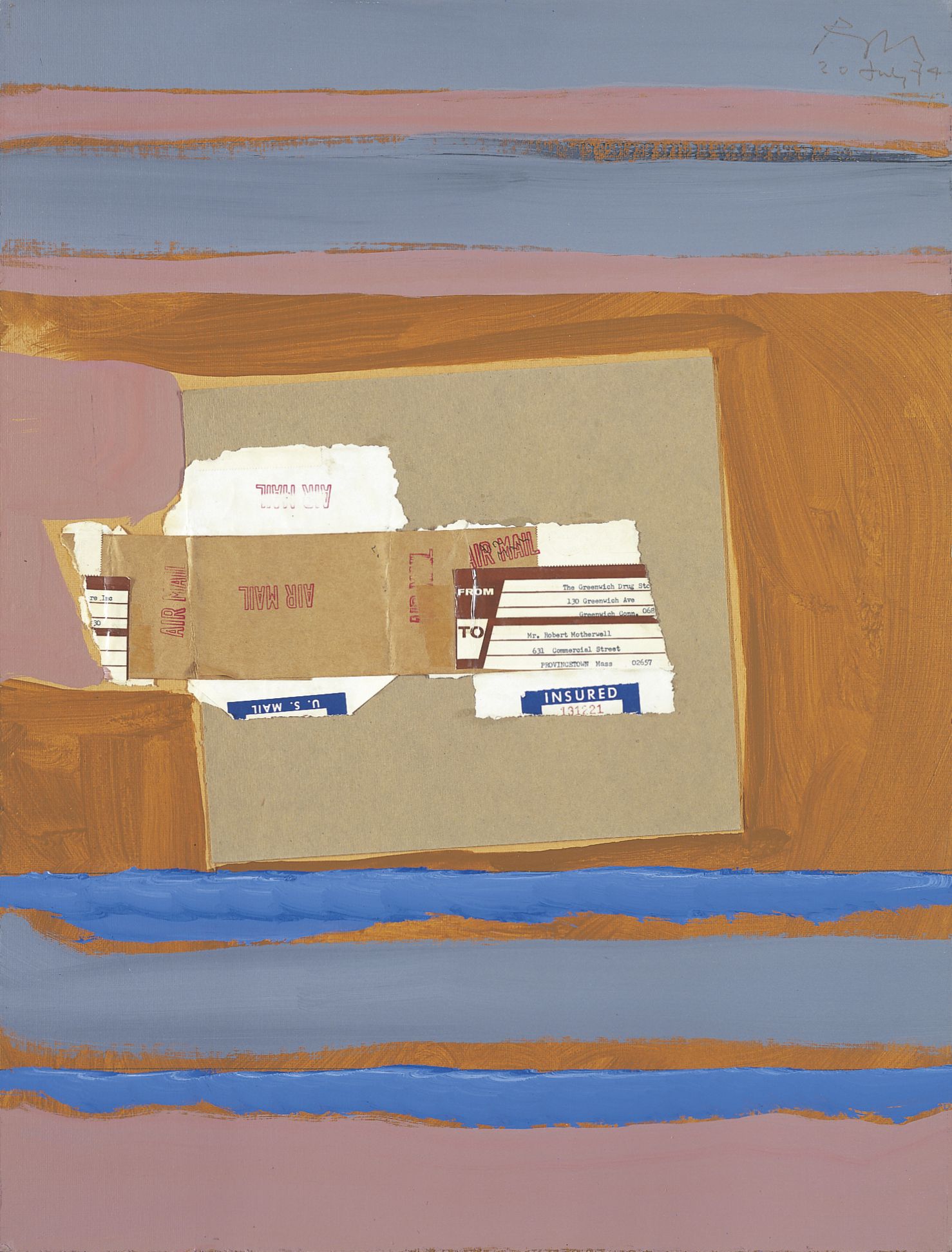
The Irregular Heart, 1974
1974
In October, Motherwell undergoes a series of five operations, including the removal of his gallbladder and the installation of a pacemaker. During the procedures he nearly dies, but within two weeks he is well enough to return home.
That fall he makes The Irregular Heart, which includes torn pieces from a package of medicine sent to Motherwell in Provincetown.
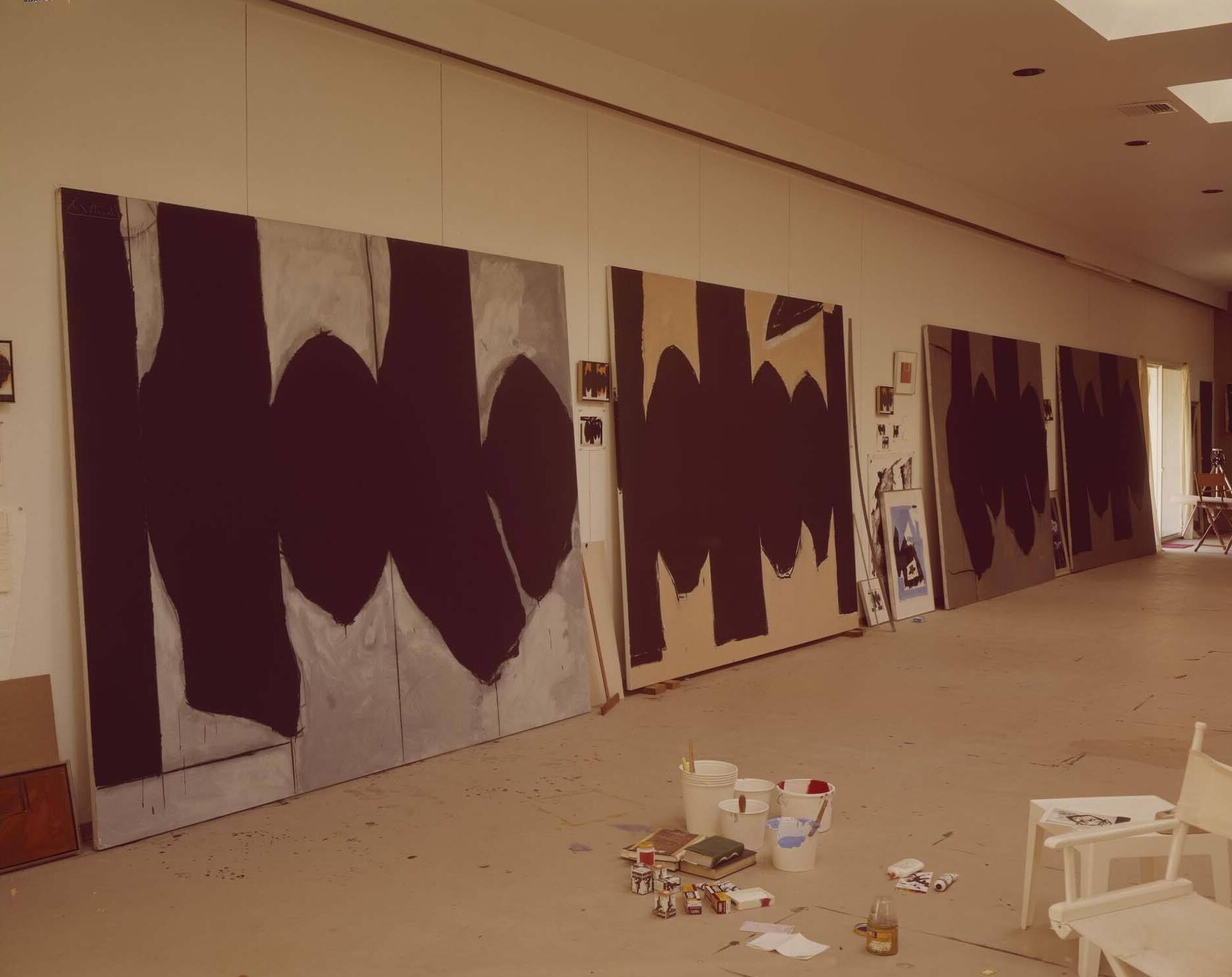
Motherwell’s Greenwich painting studio with Elegy to the Spanish Republic No. 128 and others in progress, 1975
1974
In November, Motherwell accepts a commission to paint a large mural for the new East Building of the National Gallery of Art, to be designed by I.M. Pei.
In his new painting studio, Motherwell returns to work on Elegy to the Spanish Republic Nos. 128-131, which he had started during the summer.
1975
Motherwell works on the layout and design of a monograph on his work that H.H. Arnason is writing for Harry N. Abrams.
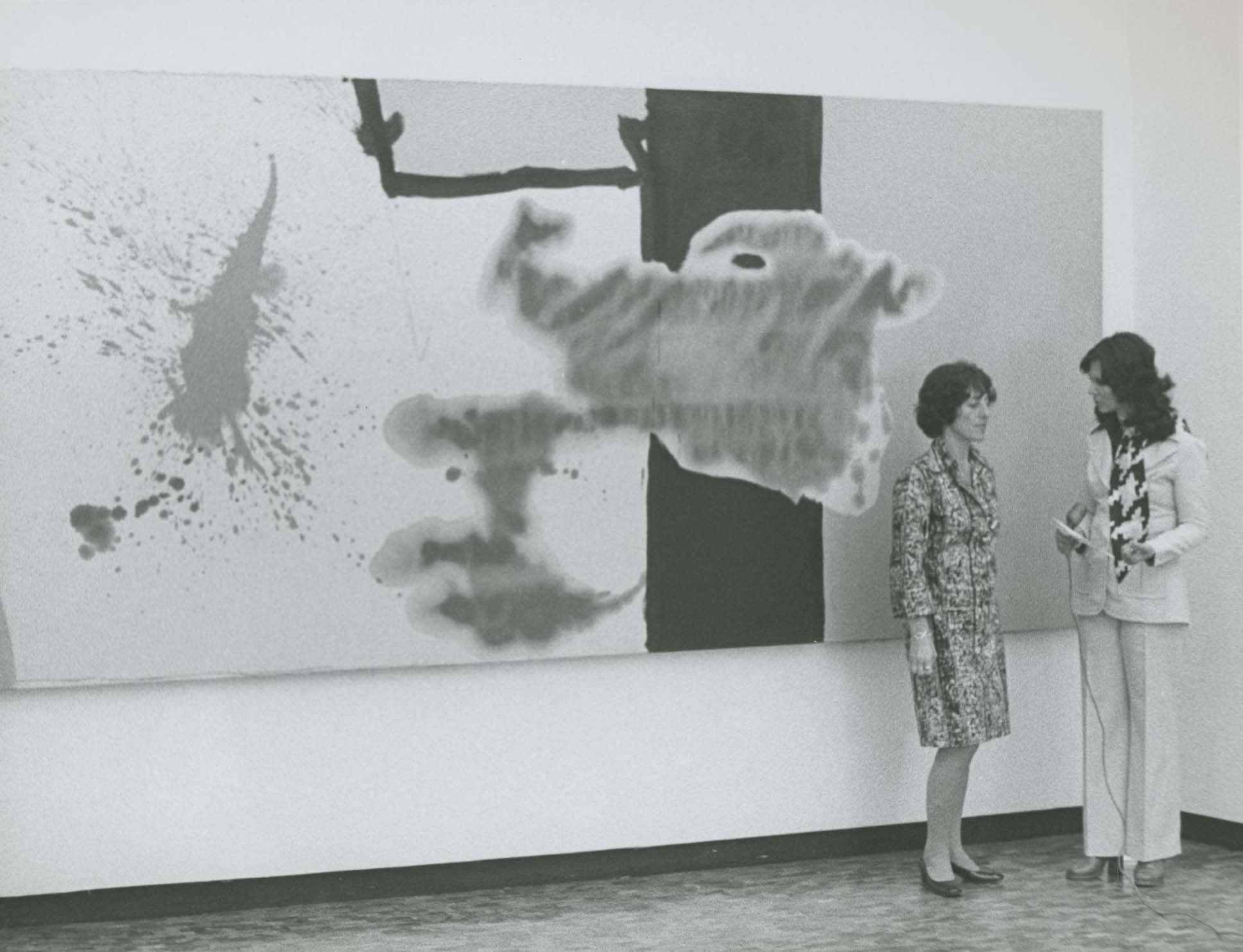
Dore Ashton (left) at the Robert Motherwell: Retrospectiva del gran pintor norteamericano in Mexico City, 1975
1975
In March, Robert Motherwell: Retrospectiva del gran pintor norteamericano, curated by Dore Ashton, opens at the Museo de Arte Moderno, Bosque de Chapultepec, Mexico City.
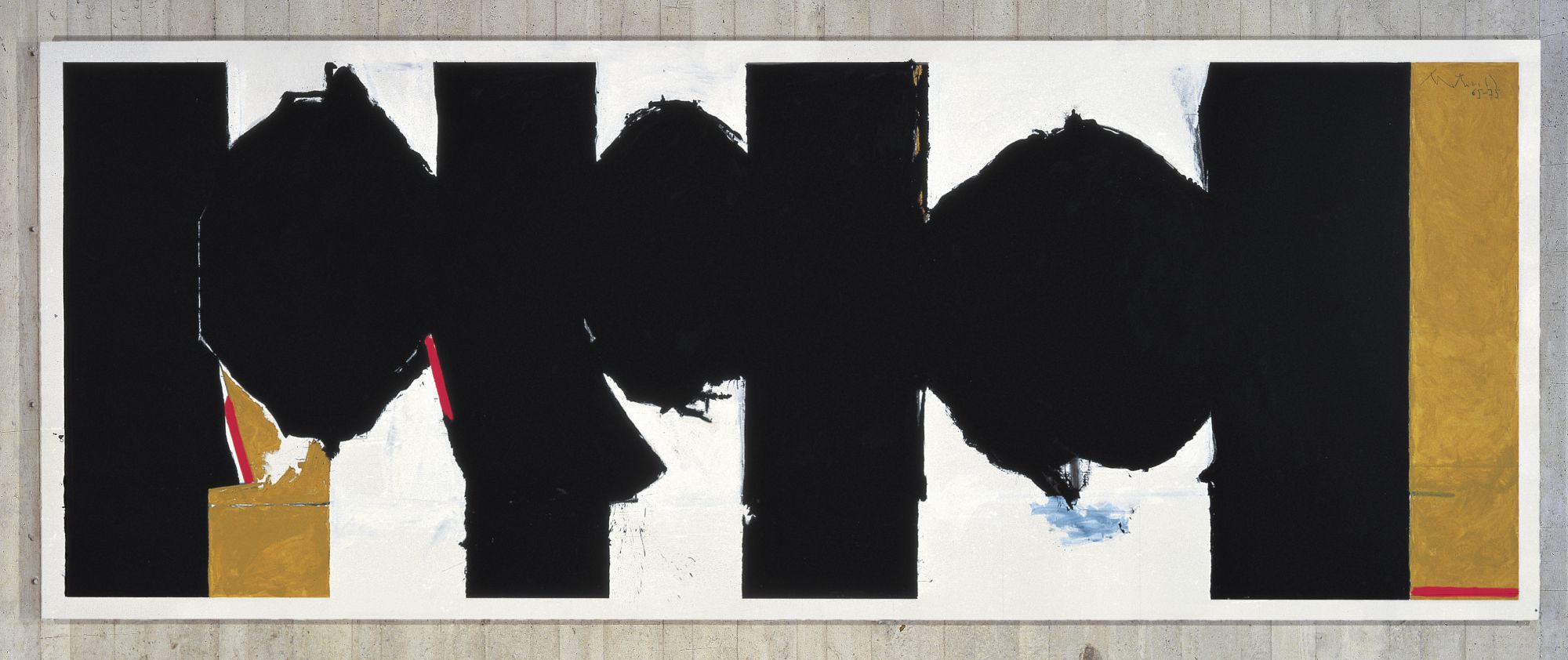
Elegy to the Spanish Republic No. 126, 1972–1975. Acrylic on canvas, 77 ¾ x 200 ¼ inches (197.5 x 508.6 cm)
1975
In April, Motherwell completes work on Elegy to the Spanish Republic No. 126, the mural for the University of Iowa Museum of Art.
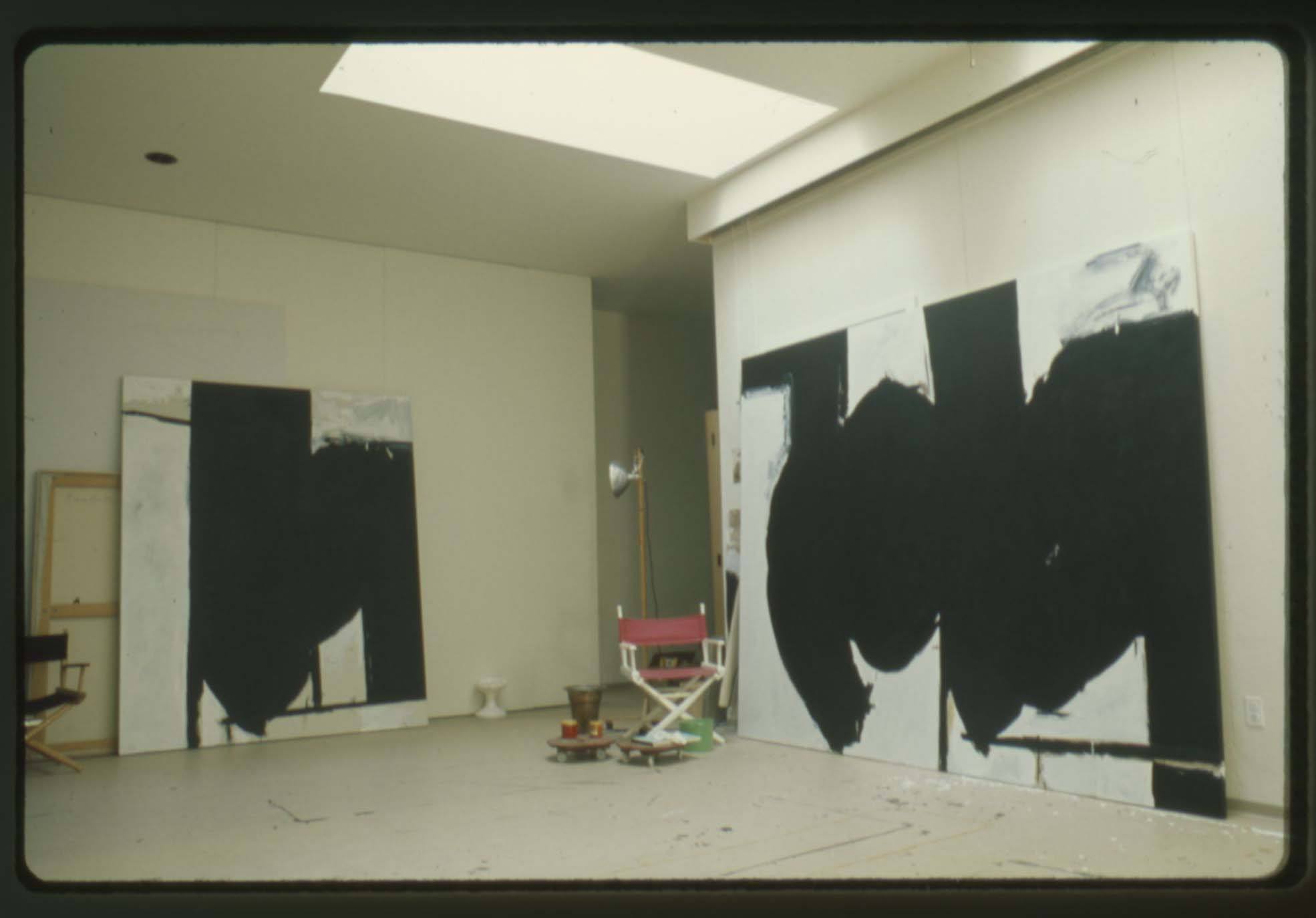
Motherwell’s Greenwich painting studio with The Spanish Death, fall 1975
1975
Motherwell paints The Spanish Death in a six-hour burst of inspiration. The “death” referred to in the title refers not only to the death of the Spanish dictator General Francisco Franco in November 1975, but also to the loss of freedom by the Spanish people under his oppressive hand.
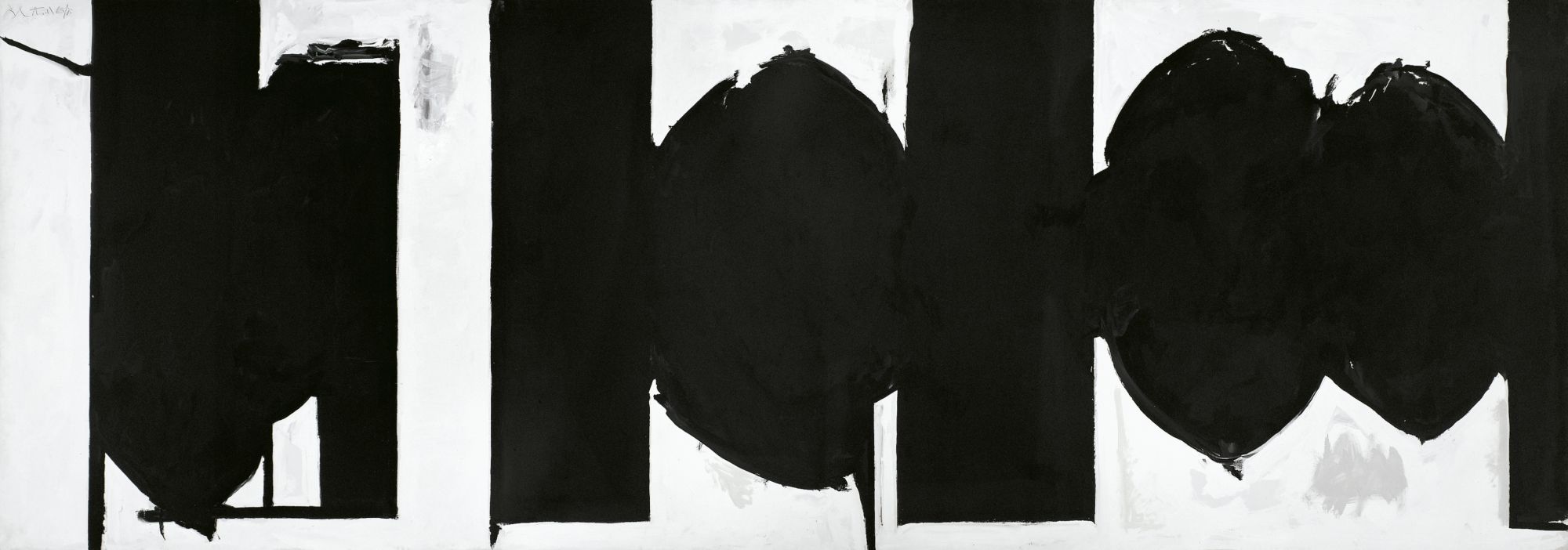
Elegy to the Spanish Republic No. 100, 1962–1963/1973–1975. Oil on canvas, 84 x 240 inches (213.4 x 609.6 cm)
1975
In November, Motherwell completes his reworking of Elegy to the Spanish Republic No. 100, first begun in 1962.
1976
In September, Robert Motherwell opens at the Städtische Kunsthalle Düsseldorf. It is the first full-scale retrospective of Motherwell’s work since 1965. The exhibition travels to Stockholm and Vienna. The catalogue features essays by Robert Hobbs on both the Elegy series and the Open series.
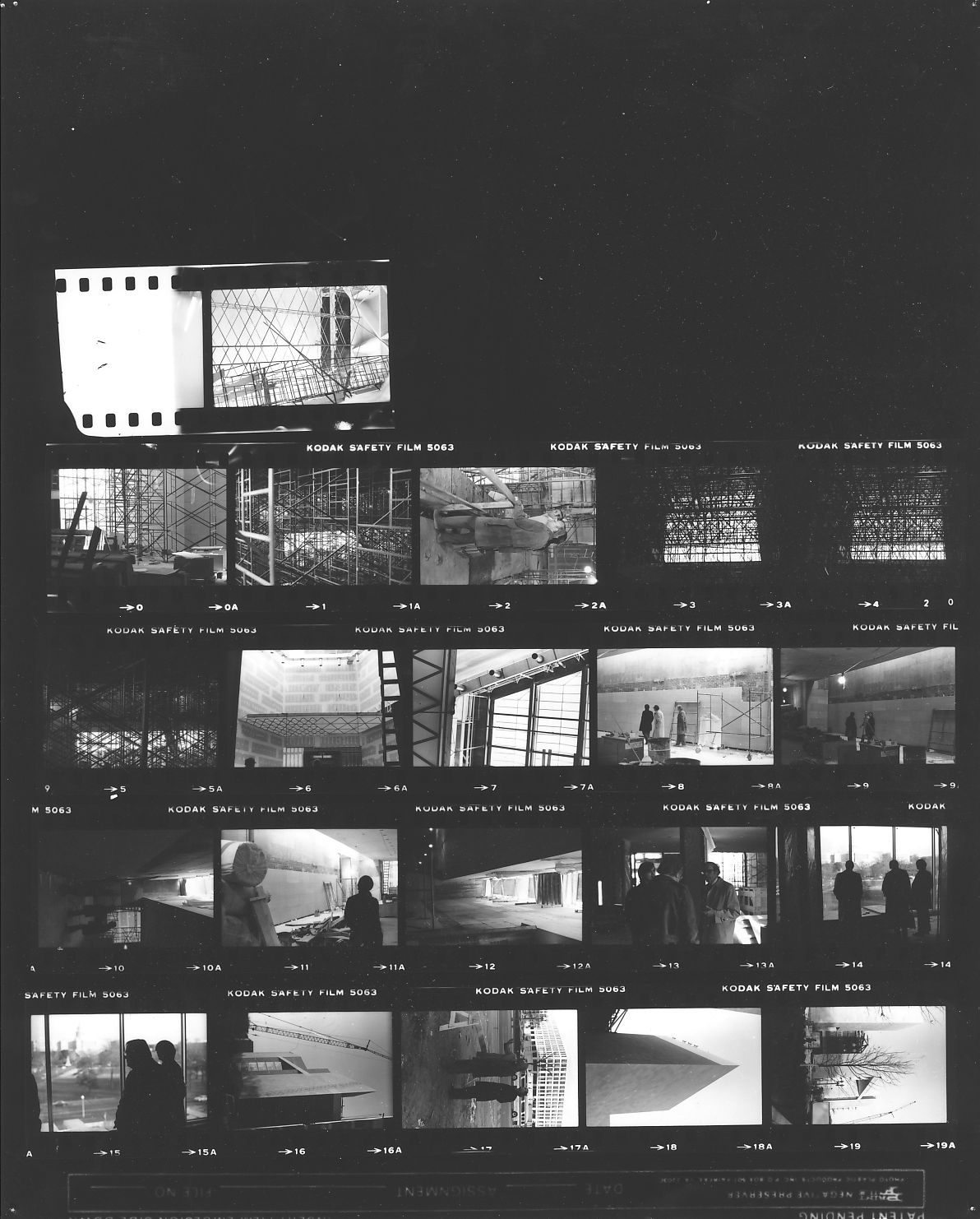
Contact sheet showing Motherwell touring the construction site of the National Gallery of Art East Wing, Washington, D.C.
1976
In November, Motherwell goes to Washington, D.C. to view the progress on the East Building of the National Gallery of Art and to meet with its director, J. Carter Brown, along with E.A. Carmean and Charles Parkhurst.
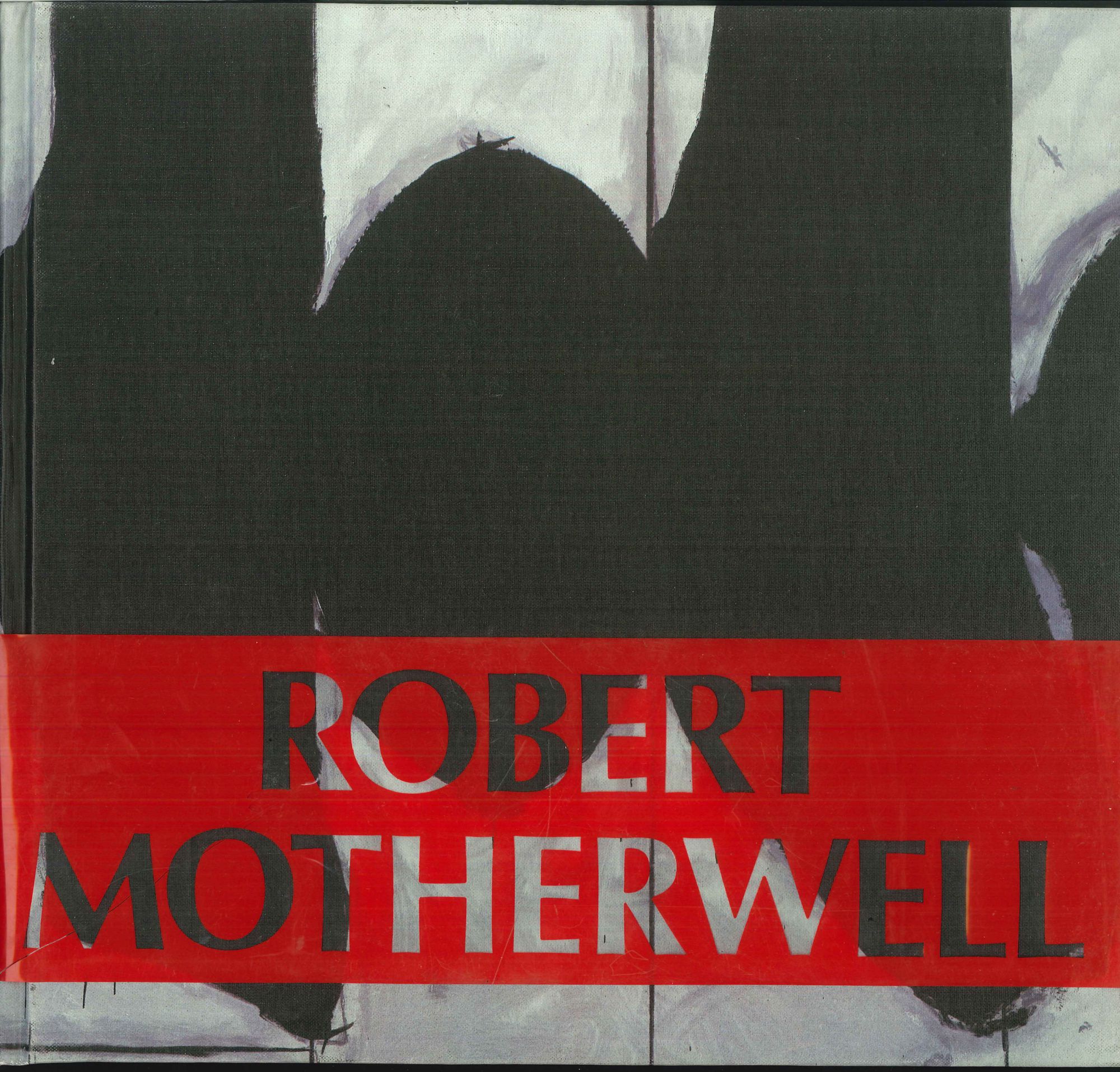
Cover of H.H. Arnason’s monograph Robert Motherwell, 1977
1977
H.H. Arnason’s monograph Robert Motherwell, with a preface by Bryan Robertson, is published by Harry N. Abrams.
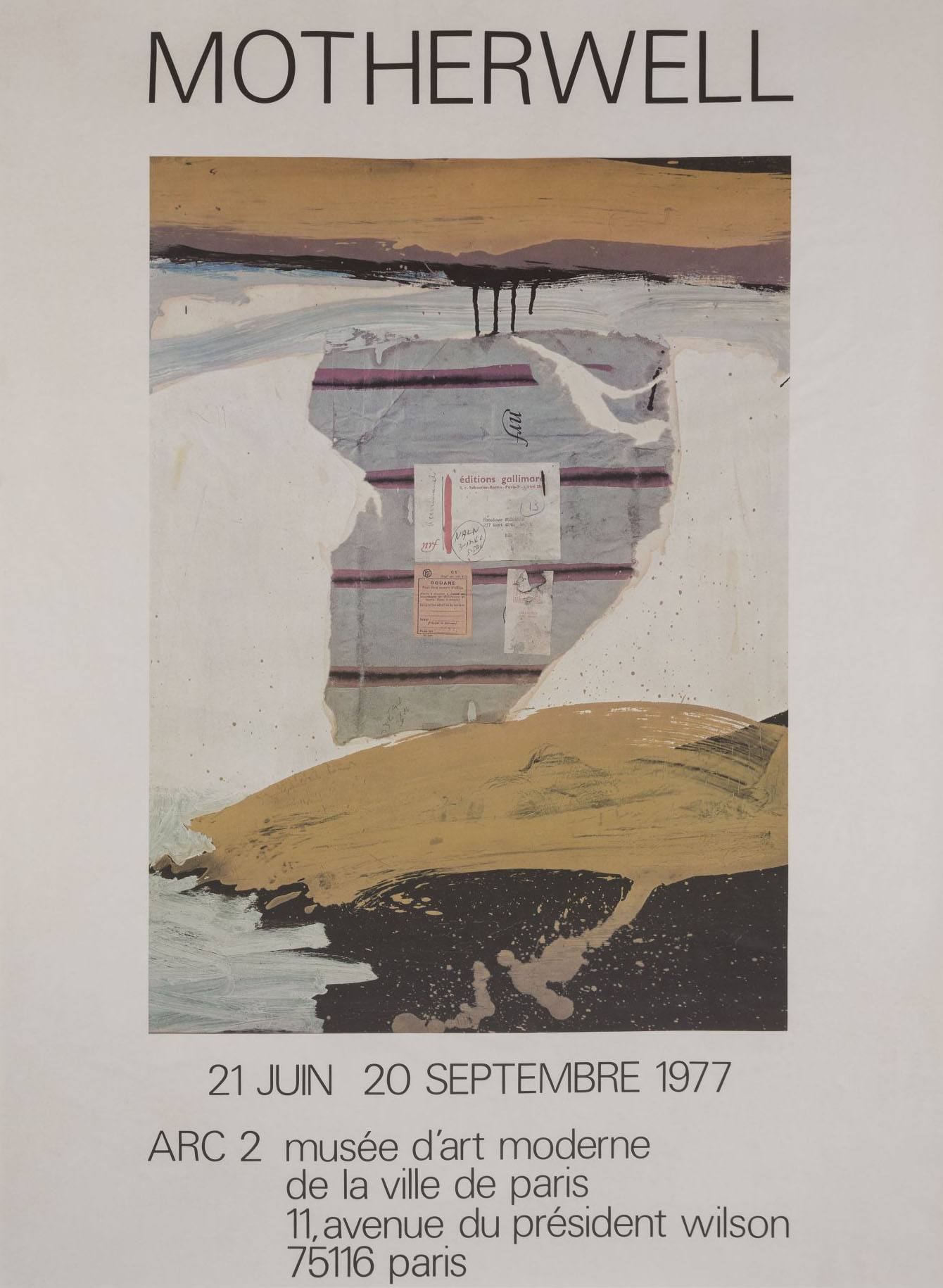
Poster from Robert Motherwell Choix de peintures et collages, 1941–1977, Musée d’Art Moderne de la Ville de Paris, 1977
1977
In June, Robert Motherwell Choix de peintures et collages, 1941–1977 opens at the Musée d’Art Moderne de la Ville de Paris. The exhibition catalogue includes texts by Suzanne Pagé and Marcelin Pleynet.
That summer, Motherwell contributes a drawing to the premier exhibition of the Long Point Gallery, an artist’s cooperative gallery in Provincetown. He is one of the founding members, along with Varujan Boghosian, Fritz Bultman, Budd Hopkins, and Judith Rothschild, among others.
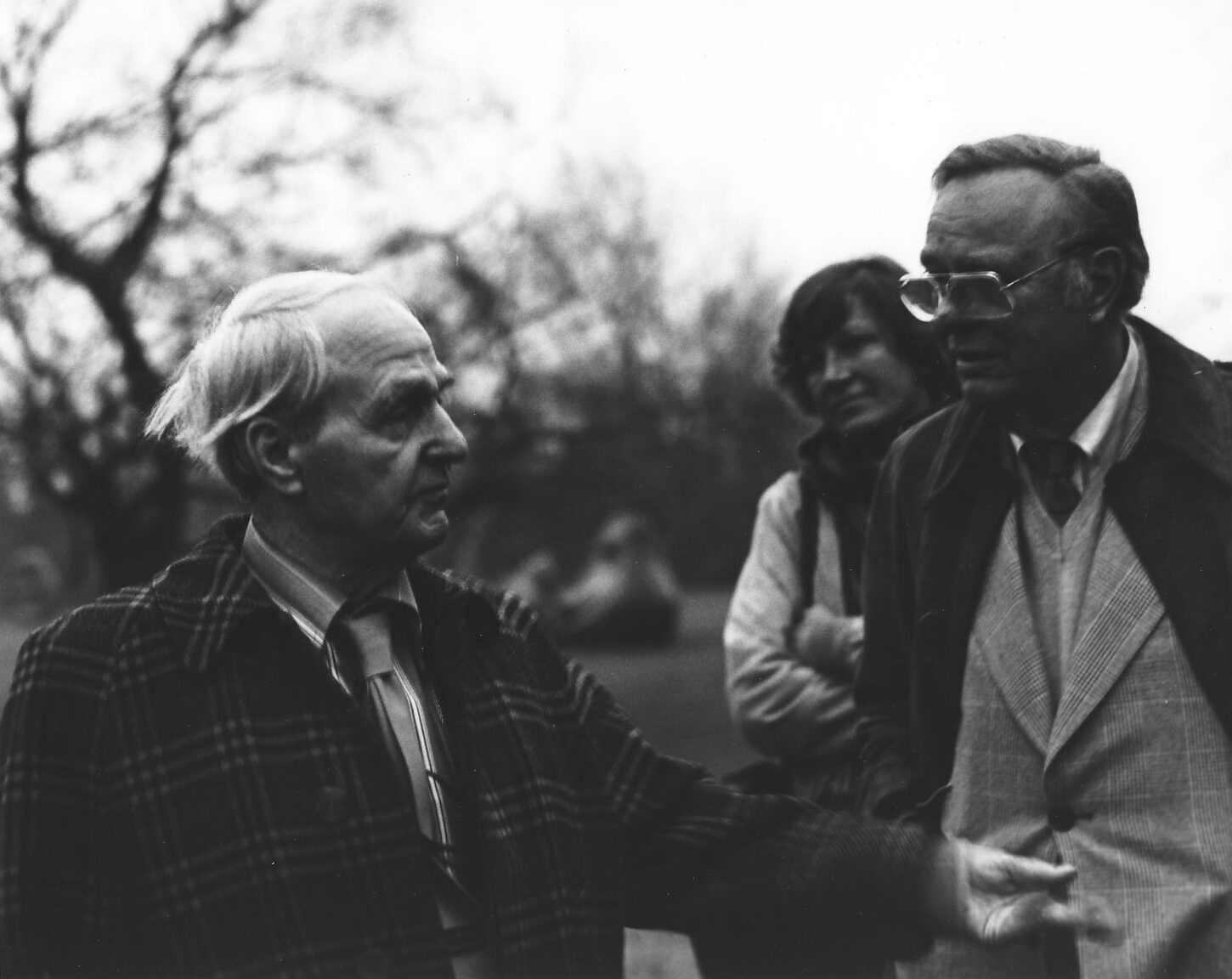
Motherwell and sculptor Henry Moore, Hertfordshire, England, January 1978
1978
In January, Motherwell attends the opening of his retrospective exhibition at the Royal Academy, London, a modified version of the Paris exhibition that includes 54 works. In London, Motherwell meets with David Sylvester, Bryan Robertson, John Kasmin, and Norman Rosenthal, and visits Henry Moore in Hertfordshire.
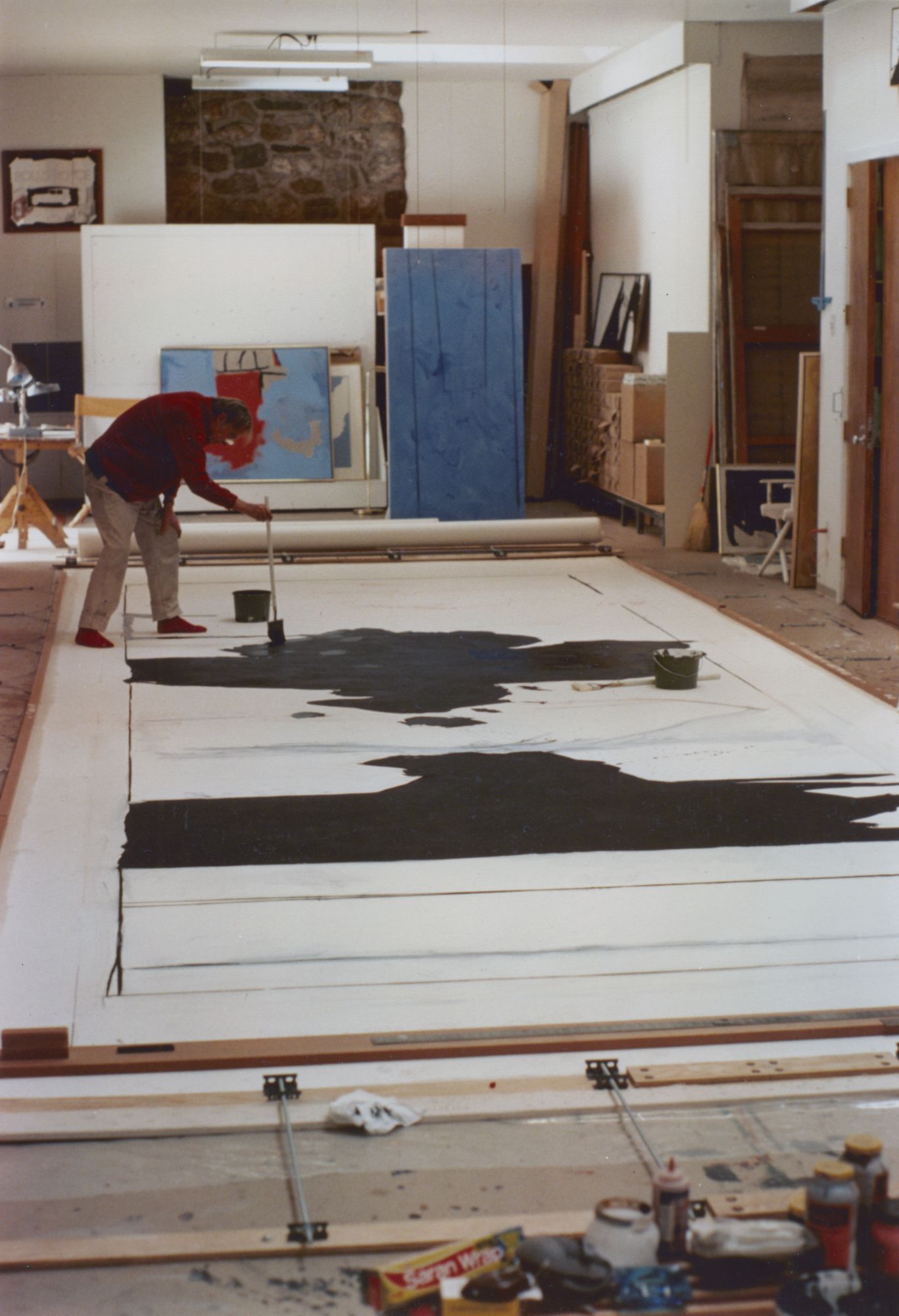
Motherwell painting Reconciliation Elegy in his Greenwich studio, 1978
In February, Motherwell finishes the mural commissioned by the National Gallery of Art for the new East Building. He titles the completed work Reconciliation Elegy.

Certificate of La Grande Médaille de Vermeil received by Motherwell from the city of Paris, 1978
1978
Mayor Jacques Chirac presents Motherwell the Grande Médaille de Vermeil de la Ville de Paris, the highest honor given by the city. Motherwell is the first American painter so honored.
1978
Abstract Expressionism: The Formative Years, curated by Robert Hobbs and Gail Levin, opens in March at the Herbert F. Johnson Museum of Art, Cornell University. The exhibition, which includes ten early works by Motherwell, travels to Tokyo and the Whitney Museum of American Art.
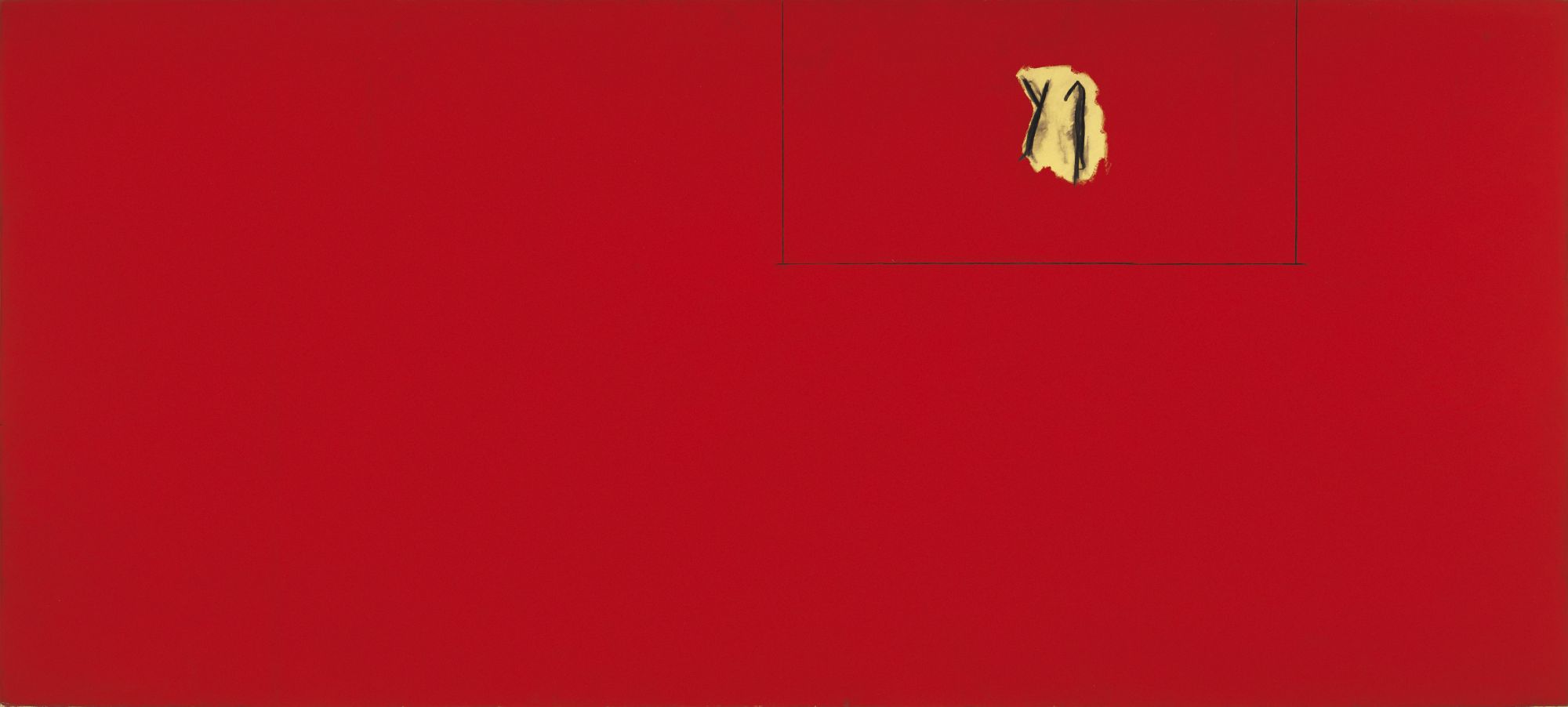
Phoenician Red Studio, 1977
1978
In April, an exhibition of thirty-nine paintings and collages at Knoedler & Company, includes the recent monumental works In Black and White No. 2, Threatening Presence, and Phoenician Red Studio.

Motherwell’s Reconciliation Elegy and Alexander Calder’s Untitled mobile installed at the National Gallery of Art, Washington, D.C.
1978
The East Building of the National Gallery of Art opens to the public on June 1 with three commissioned works: Motherwell’s Reconciliation Elegy, a large mobile by Calder and a tapestry by Miró. The exhibition American Art at Mid-Century: The Subjects of the Artist, curated by E.A. Carmean Jr. and Eliza Rathbone opens on the same day.
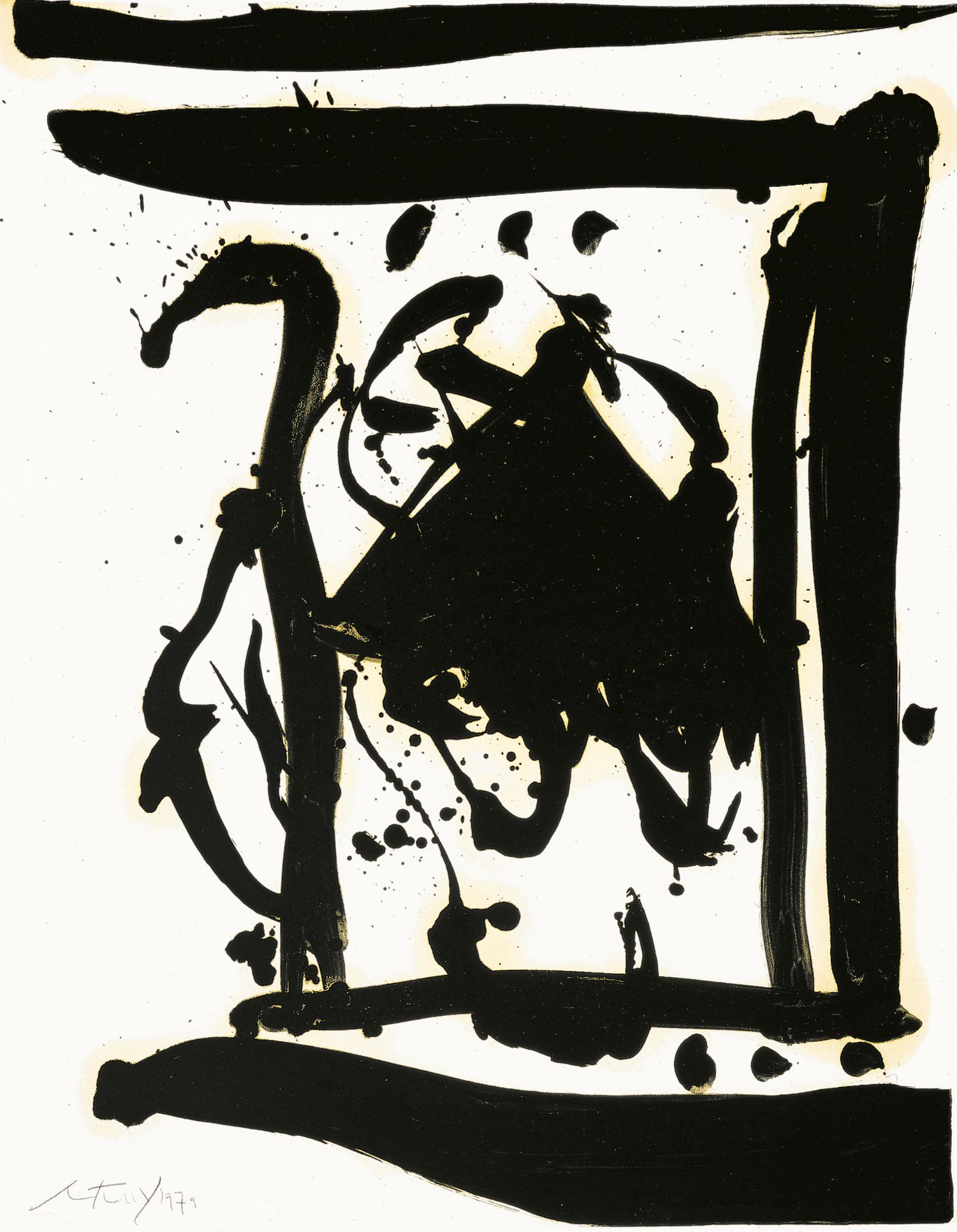
Drunk with Turpentine No. 2 (Stephen’s Gate), 1979. Oil and graphite on paper, 28 ¾ x 22 ¾ inches (73 x 57.8 cm)
1979
Motherwell invites Jack Flam to serve as co-editor of the Documents series when it is reactivated under the publisher G. K. Hall, with the slightly modified title, Documents of Twentieth Century Art.
Motherwell executes the first fifteen oil on paper paintings in what will become the Drunk with Turpentine series. By the end of the year, the series will total nearly one hundred works.
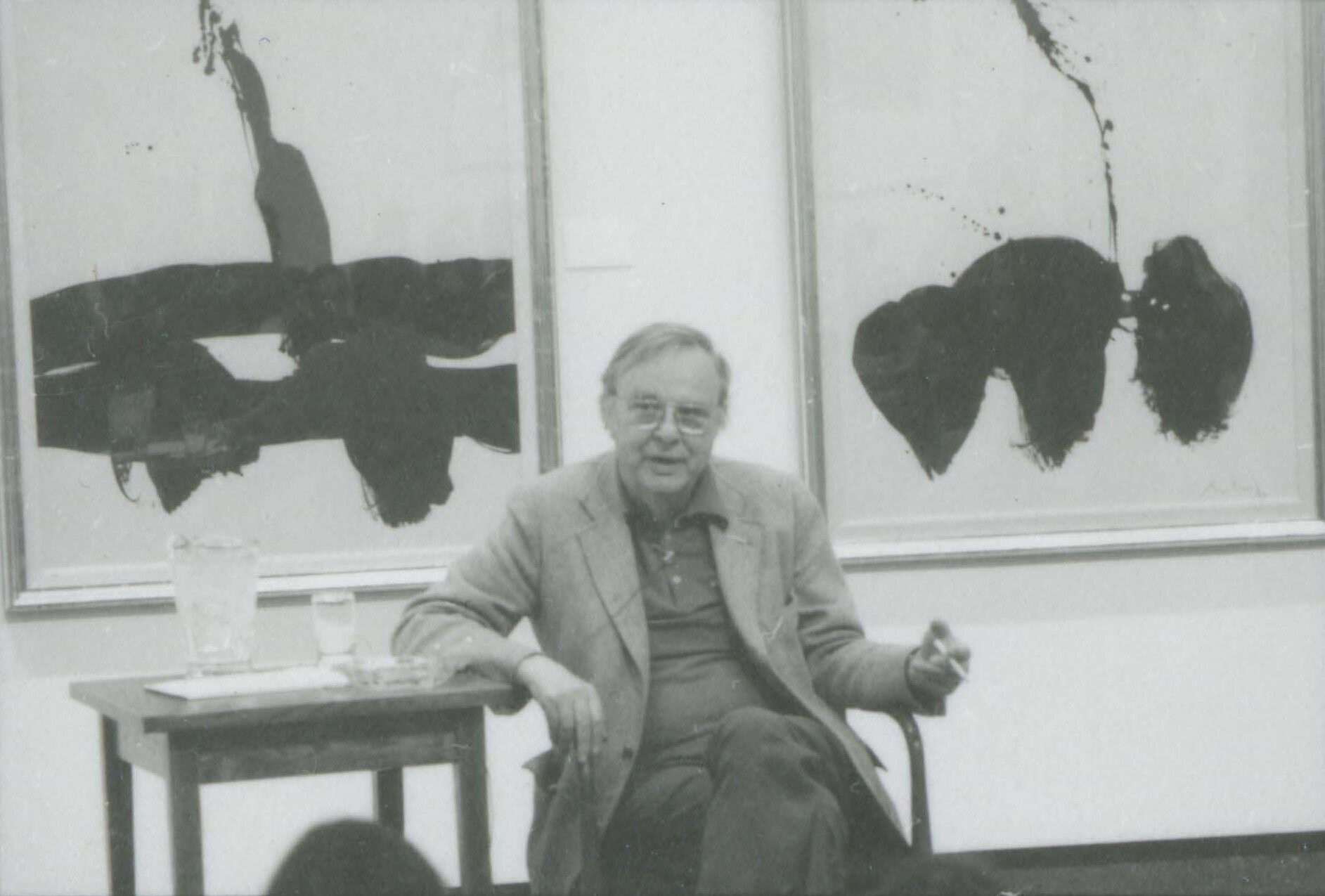
Motherwell speaking with students at the University of Connecticut, Storrs, 1979
1979
Robert Motherwell & Black, curated by Stephanie Terenzio, opens in March at the William Benton Museum of Art, University of Connecticut, Storrs. Motherwell participates in a conversation with students at the museum.

Mexican Night, 1979
1979
In Provincetown that summer, Motherwell begins a number of large paintings that show the influence of the Drunk with Turpentine series, including Mexican Night.
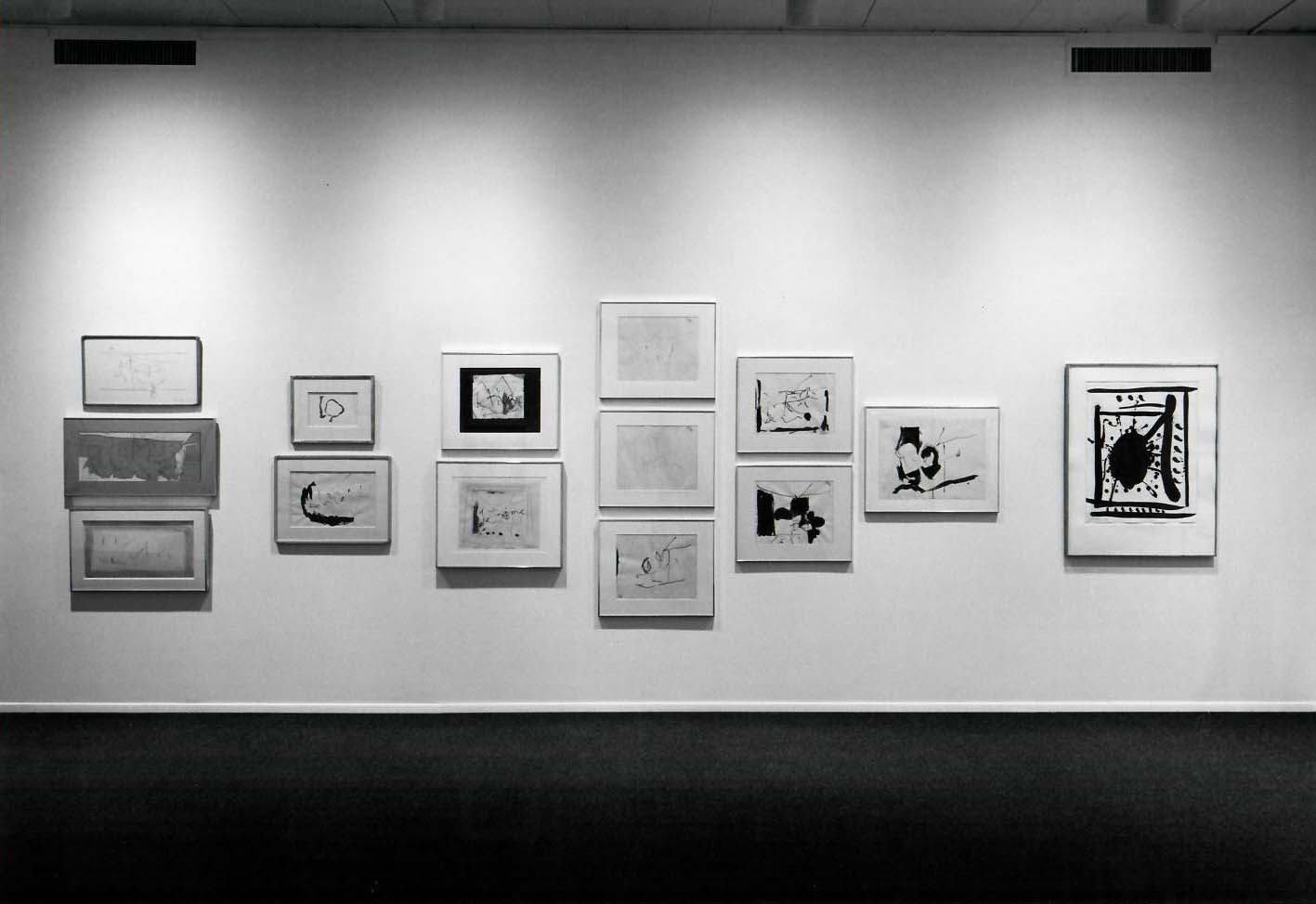
Installation view of Robert Motherwell Drawings: A Retrospective, 1941 to the Present at the Janie C. Lee Gallery, Houston, December 1979
Stephanie Terenzio becomes a close collaborator over the next decade, working on an unpublished memoir with Motherwell and editing the first edition of the Collected Writings of Robert Motherwell (Oxford University Press, 1992).
In November, Robert Motherwell Drawings: A Retrospective, 1941 to the Present, the first retrospective exhibition of Motherwell’s drawings, organized by Jack Flam, opens at the Janie C. Lee Gallery, Houston.

